Your customers are your company’s most valuable assets.
So, you need to have a solid customer acquisition strategy that consistently brings new customers to your business. Helping you generate more revenue and sustainable growth.
In this guide, we’ll show you how to build a powerful customer acquisition strategy that attracts new leads and turns them into loyal customers.
But first, let’s start with the basics.
What Is Customer Acquisition?
Customer acquisition is the process of bringing new customers to your business. Through channels like social media, search engines (like Google), and email marketing.
Customer acquisition involves identifying, reaching, engaging, and nurturing potential customers through these channels. And ultimately converting them into paying customers.
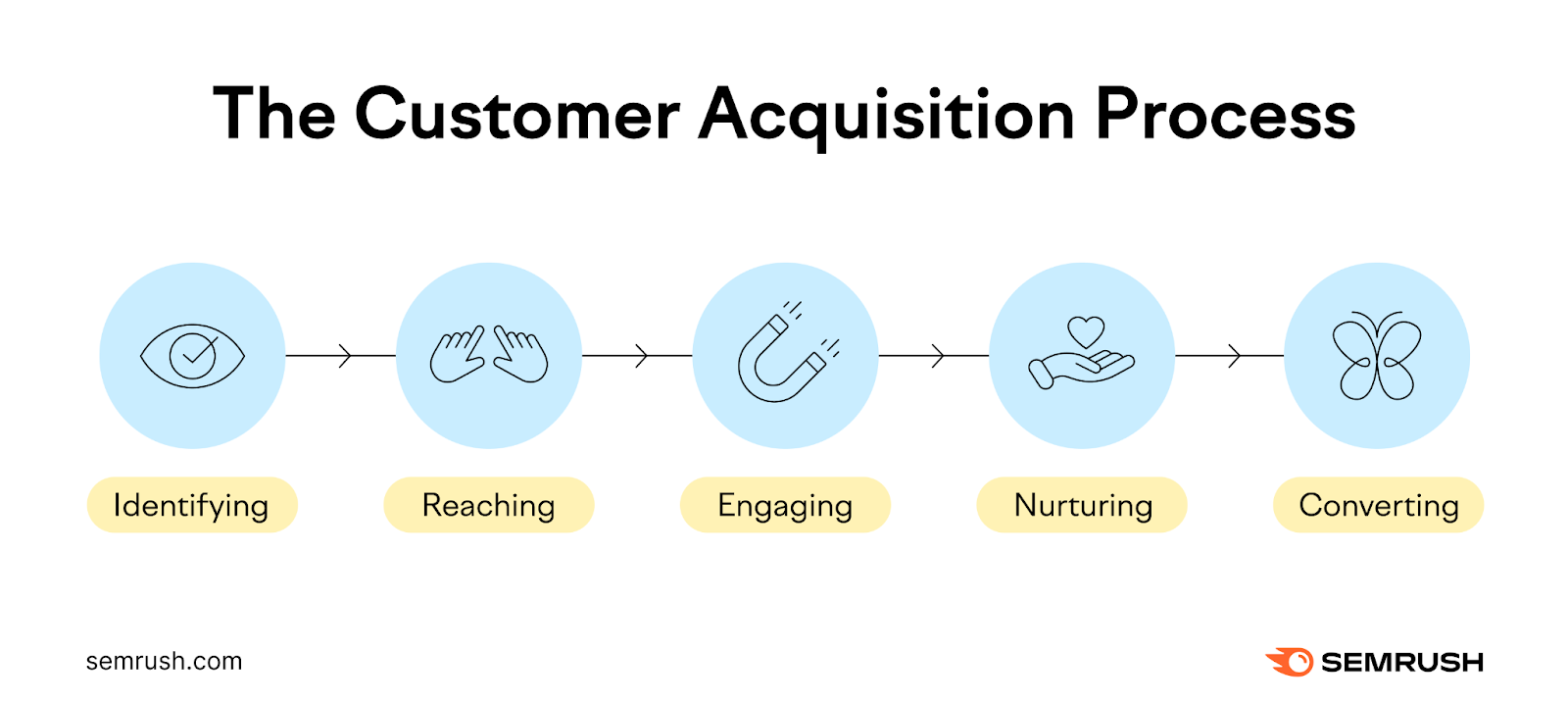
The primary goal of customer acquisition is to engage your potential customers in ways that build trust, interest in what you have to offer, and a willingness to make a purchase.
In this way, customer acquisition goes hand-in-hand with customer retention.
Customer Acquisition vs. Customer Retention
Customer acquisition focuses on acquiring new customers.
Customer retention is the process of turning your existing customers into repeat buyers.
Both are closely linked and essential for long-term success and business growth. But you can’t retain customers without acquiring them in the first place.
Further reading: 65 Customer Retention Statistics You Need to Know in 2024
Why Is Customer Acquisition Important?
Customer acquisition helps you expand your customer base. And it counterbalances the natural attrition of your existing customer base.
Because no matter how good a company’s customer retention strategy is, they’re likely to lose some existing customers over time.
Having a powerful customer acquisition strategy lets you offset these inevitable losses. Helping your business not only maintain a balance but also a steady pace of growth.
Customer acquisition is also important for:
- Market expansion: Acquiring new customers from untouched segments can help you diversify your customer base. And reduce your dependence on a single market.
- Increased brand awareness: As your customer base grows, so does the chance of other people hearing about your brand through word of mouth. Helping you increase brand awareness and build a solid reputation in the market.
- Gather feedback: New customers bring new feedback and demands. Which can help you drive improvements in your products or services.
The 3 Main Customer Acquisition Stages
At any given time, your customers are at different stages of the buyer’s journey. This journey can be summarized into a funnel of three customer acquisition stages:

1. Awareness
In the awareness stage, potential customers understand that they have a specific need or problem. And they may (or may not) be actively looking for a solution. They also likely don’t have a product or service in mind yet.
This is your opportunity to grab their attention and introduce them to your brand. By addressing and providing a solution to their problem.
Imagine you sell an online fitness course. Your potential customers include people who feel less energetic and struggle to stay motivated throughout the day.
They search for queries like “how to get fit” or “how to increase energy levels” on Google.
Here, they realize they have a problem and need a solution. But they aren’t necessarily looking to make a purchase yet.
2. Consideration
In this stage, potential customers explore different solutions to solve their problem. This is your opportunity to show how your solution stands out from the alternatives.
Your potential customers have realized that subscribing to an online fitness course can help them.
They now search for queries like “best online fitness courses” on Google. To compare the different options and find the best fit for them.
3. Conversion
Conversion is the final stage where potential customers make the decision to purchase your product or service.
Your potential customers have compared different online fitness courses. And are now leaning toward your course.
This is where having an effective conversion rate optimization strategy comes into play.
Top Customer Acquisition Channels
Here are the best customer acquisition channels to consider, no matter what type of business you run:
1. Organic Search
Organic search refers to unpaid listings that appear in search engine results pages (SERPs).
Here’s an example of a website ranking organically for the keyword “best project management software”:
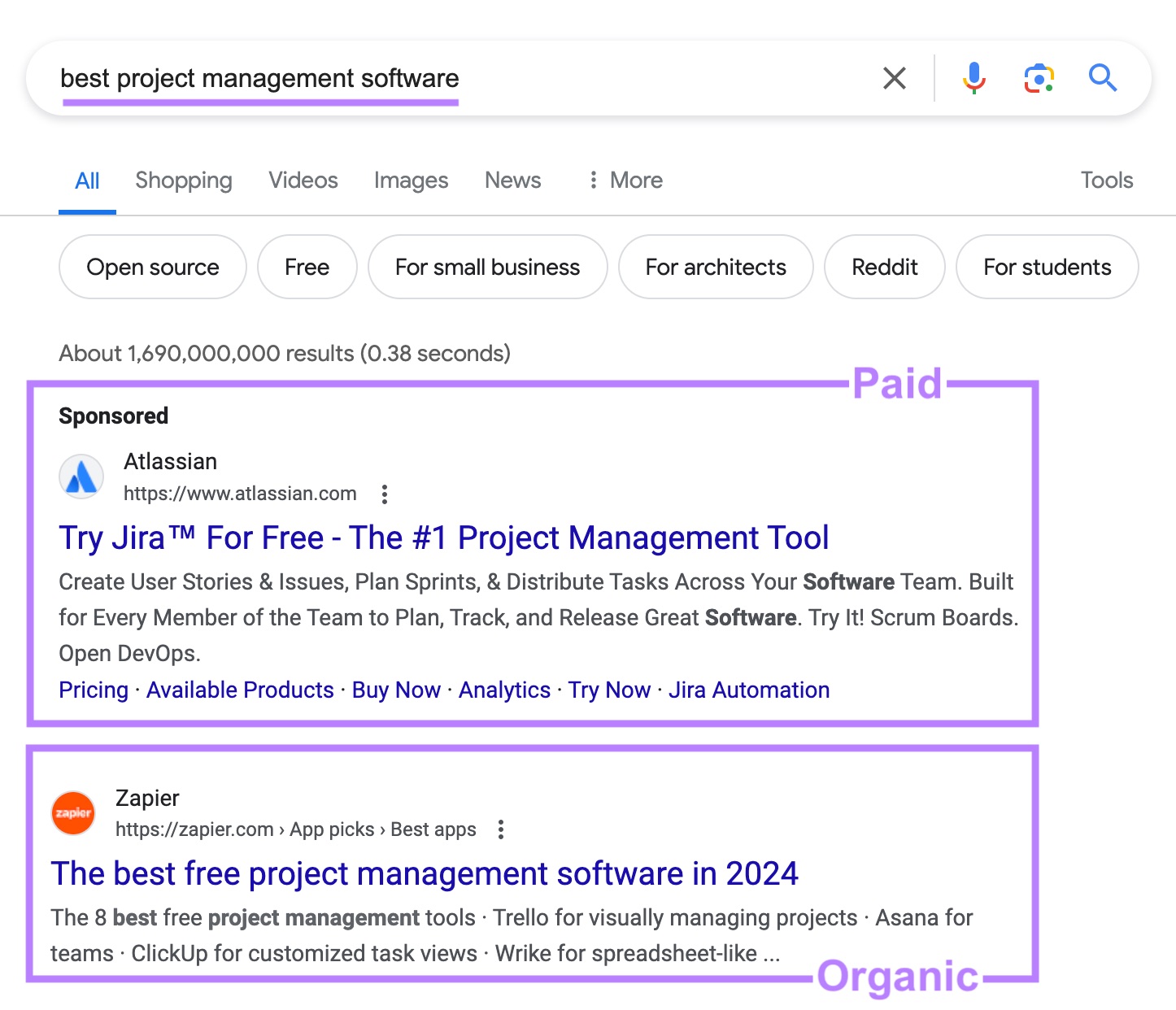
Why leverage organic search as a customer acquisition channel?
Because Google processes 6.3 million searches each minute. Bing has more than 100 million daily active users across the globe.
Search engines like Google, Bing, and Yahoo are the go-to places for many people to find answers to their queries. And—importantly—to discover products and services.
Standard organic search listings represent great opportunities for customer acquisition. For example, a potential customer at the beginning of the buyer’s journey might search for a term like “what is padel tennis” and see results like below:
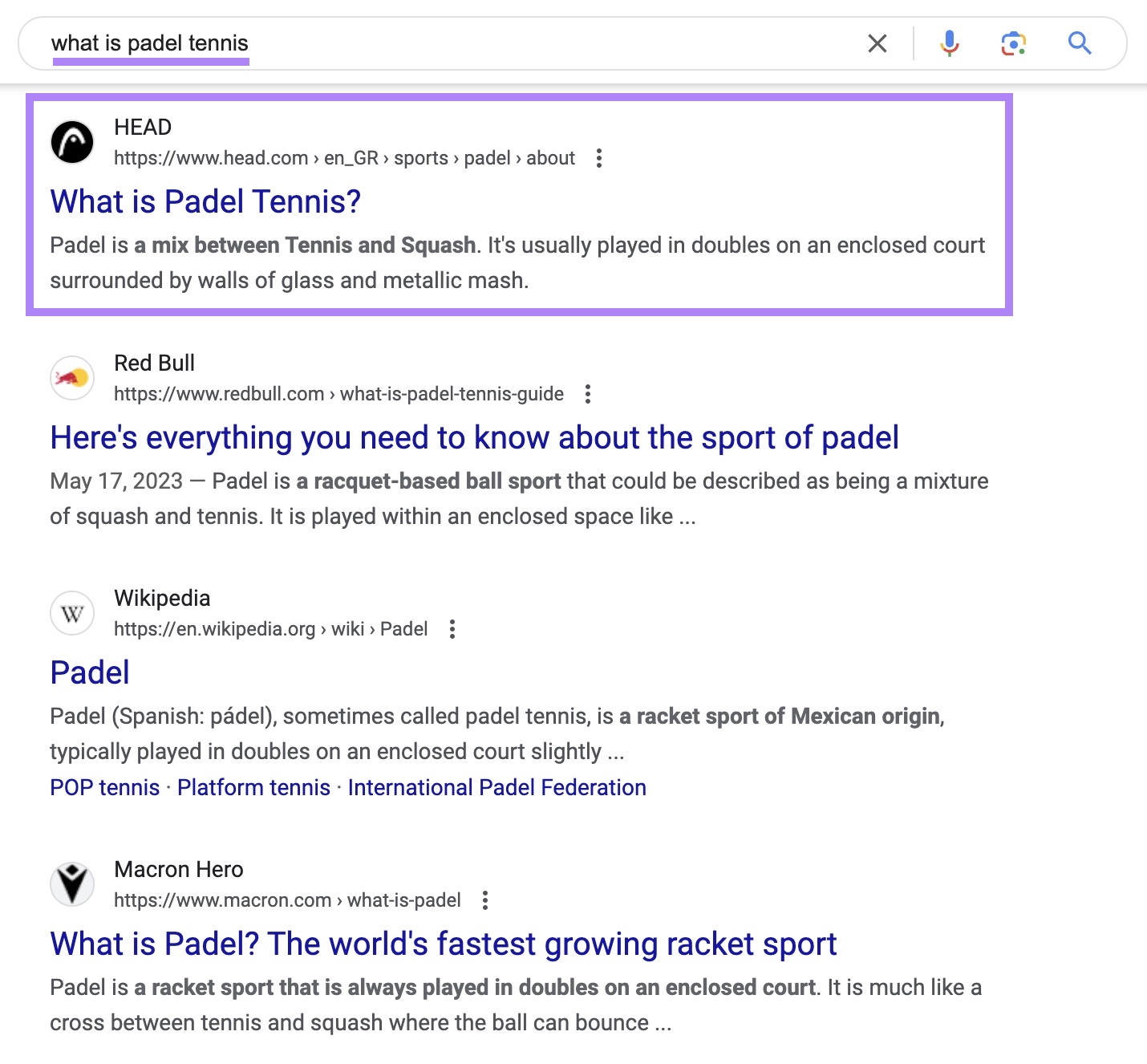
The top result is from Head, a sports company that sells padel racquets. They include links to their products in this article. Showcasing organic search as a viable customer acquisition channel.
But organic search is also a powerful acquisition channel for small and local businesses.
Imagine you own a plumbing business. And you target potential customers in your local area.
Your target audience might search for the keyword “plumbing services london” and see your website ranking in the local pack.
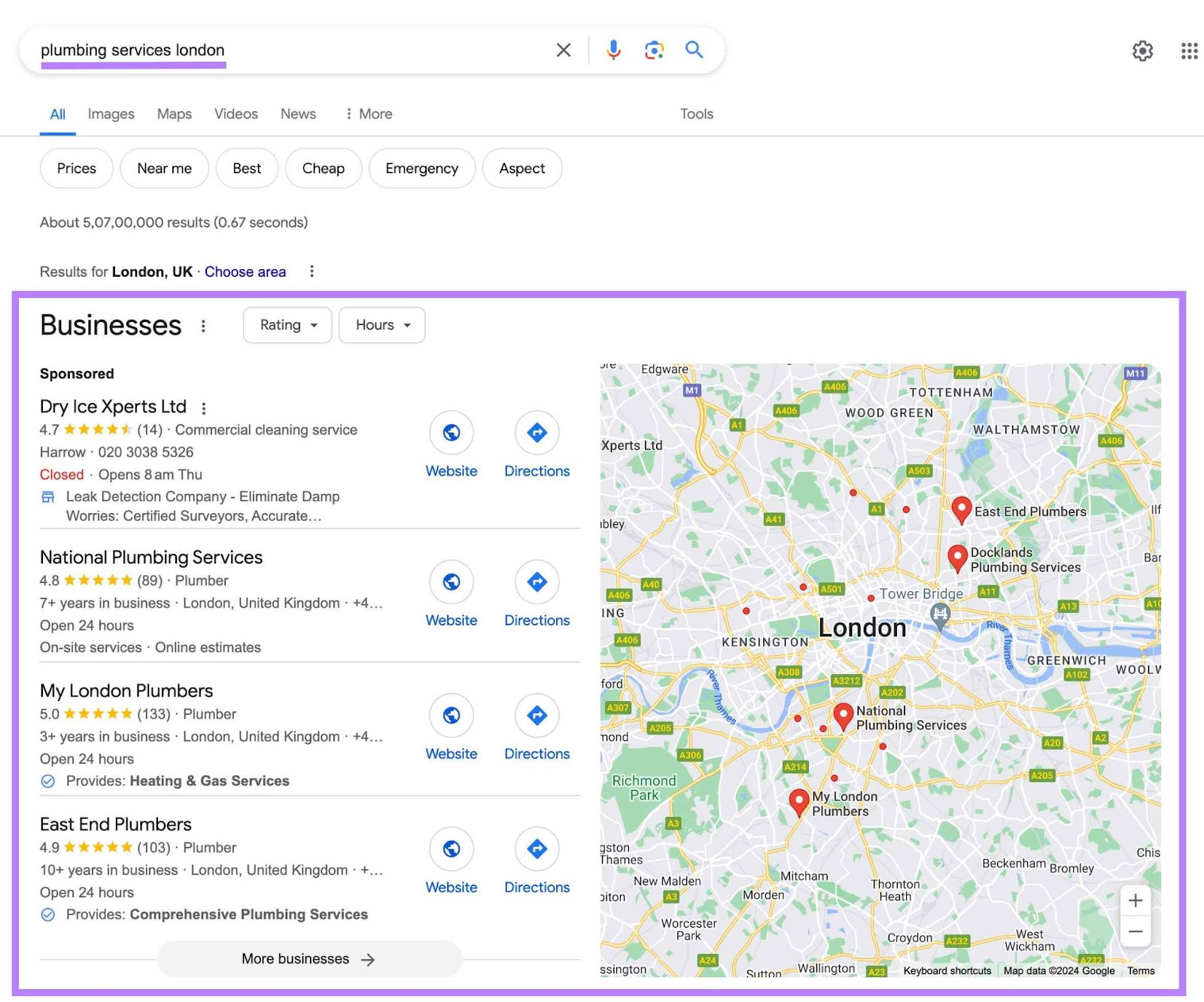
Appearing in the local pack can:
- Increase your business’s visibility
- Provide users with key information about your business (like where it is on the map)
- Build credibility
2. Paid Search
Paid search refers to paid search results. These results are typically labeled as “Sponsored” or “Ad.”
Here’s an example of a paid search ad ranking for the query “web hosting provider”:
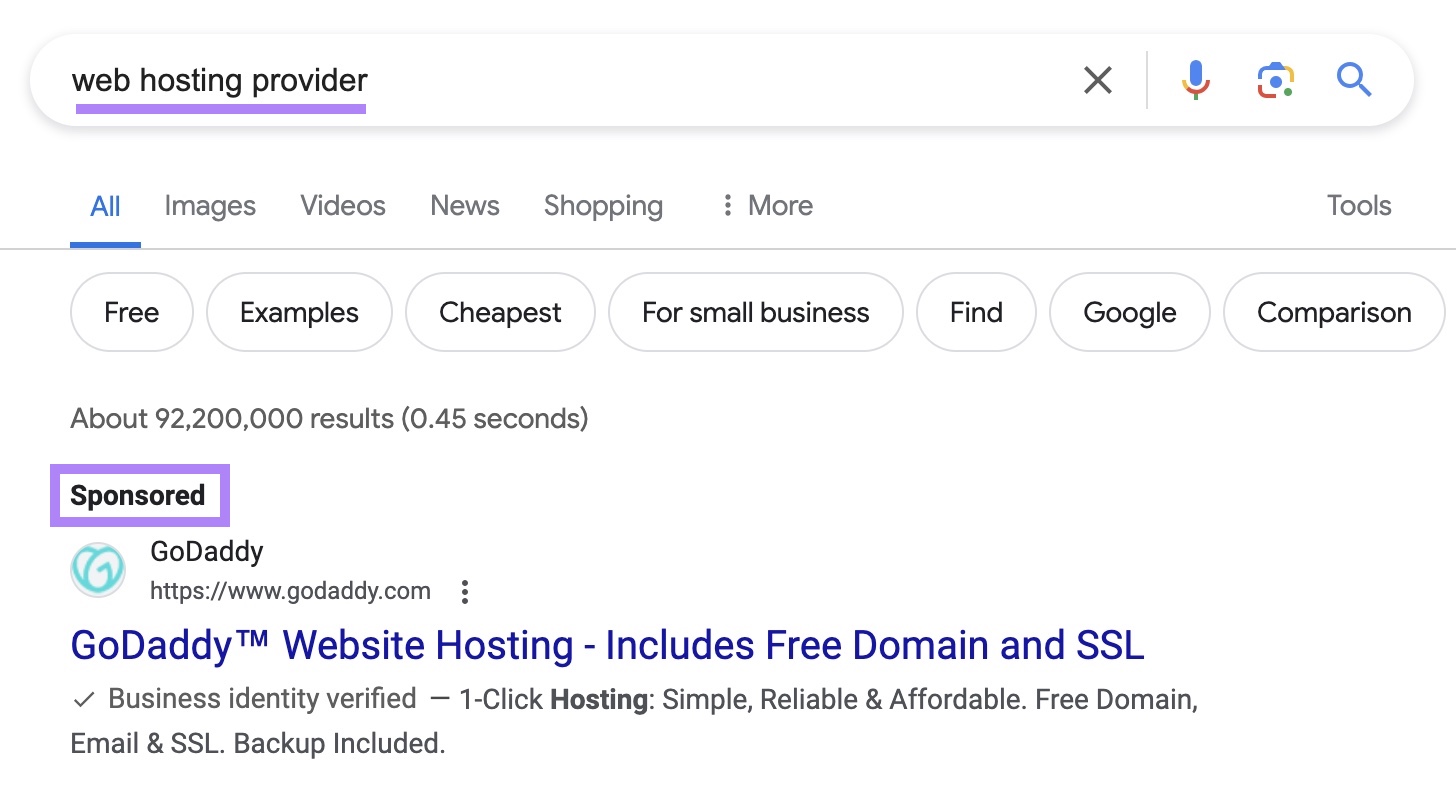
To leverage paid search as a customer acquisition channel, you need to run a paid ads campaign.
On search engines, paid ads typically run on a pay-per-click (PPC) basis. PPC is a business model where an advertiser pays a fee each time someone clicks on their ad.
When you launch a PPC campaign, your ads can appear in front of your target audience almost instantly. And the moment you stop funding your PPC campaign or your ad budget runs out, the visibility and traffic from these campaigns come to an immediate stop.
Aside from traditional search ads that appear like those in the image above, you’ll also find paid ads in Google’s Shopping tab.
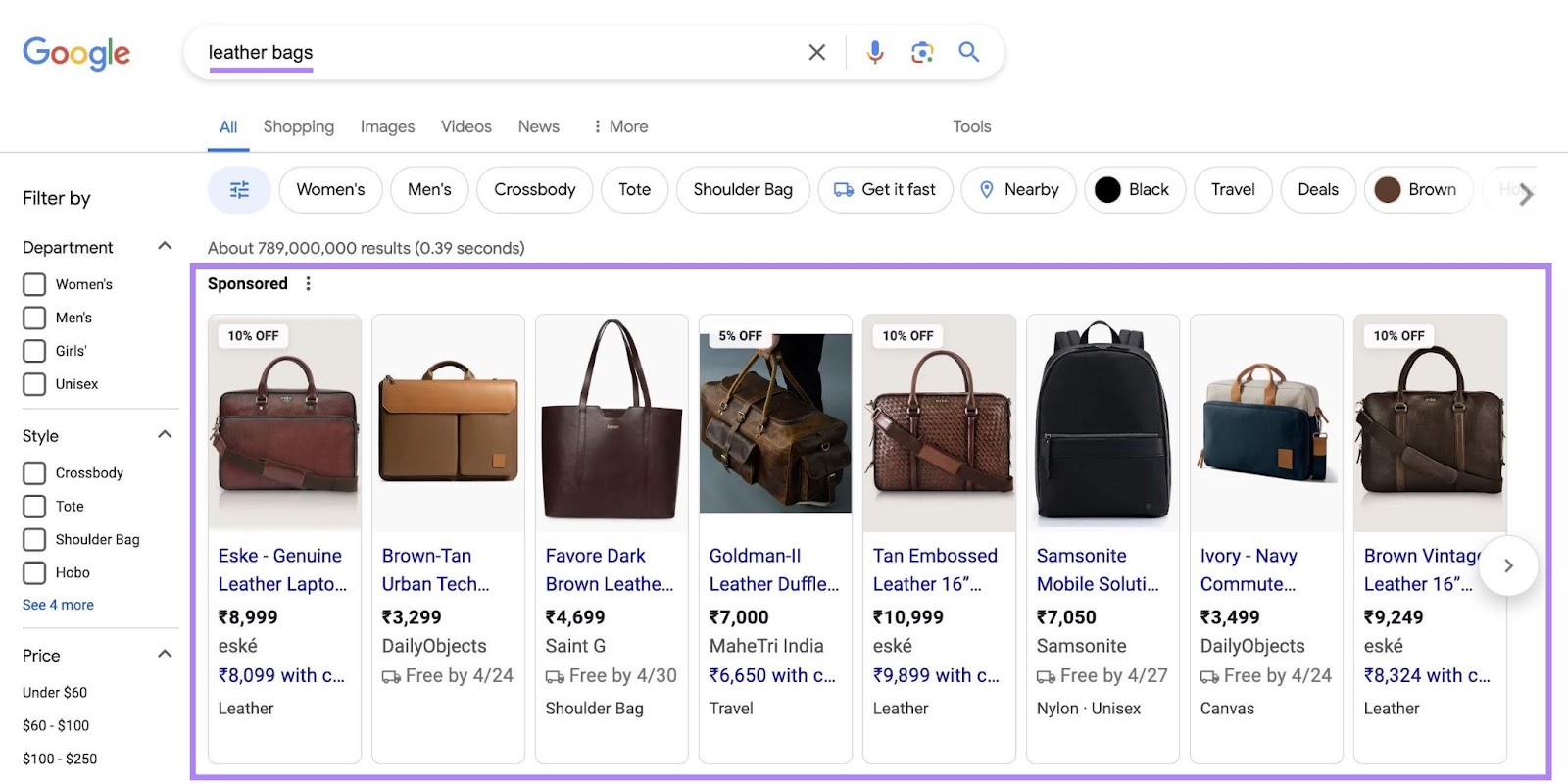
People browsing this tab for search terms are likely in the consideration or perhaps even conversion stage of the customer acquisition funnel. Making paid ads in this area a useful channel for businesses that sell products.
You can also find paid ads in areas like the local finder, which appears when you expand the local pack.
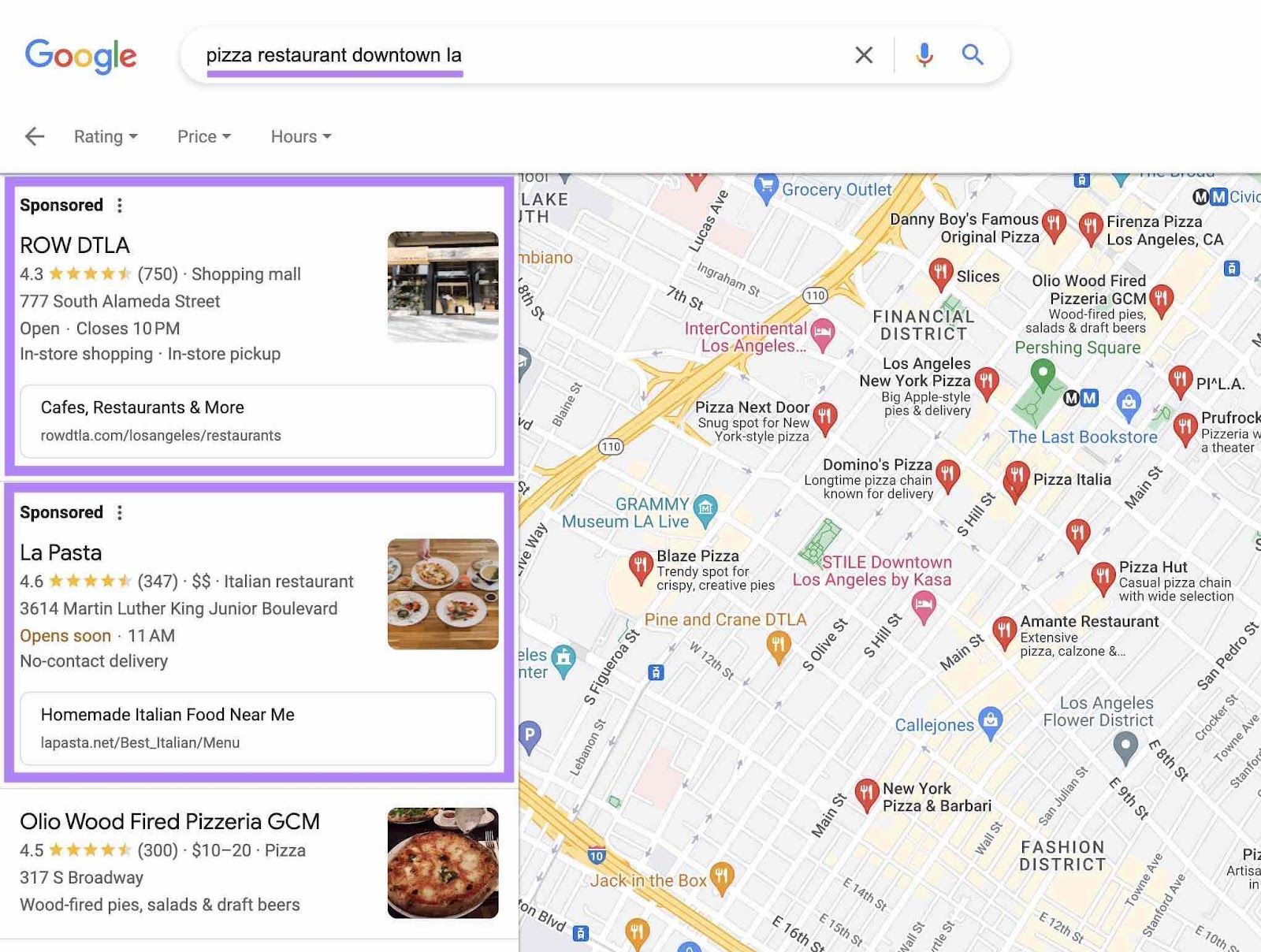
As with appearing in the local pack organically, this is a useful place to get your local business in front of searchers that are likely ready to spend money.
3. Organic Social
Organic social refers to unpaid social media content.
As with organic search, you don’t have to pay money to put your content in front of your target audience. Instead, your audience discovers it naturally.
Here’s an example of social media post from Chewy organically appearing in Instagram’s reel section:

People spend an average of more than two hours on social media each day. And social media platforms have billions of active users.
But which platform(s) should you choose?
Identify the ones where your target audience hangs out the most. And makes purchasing decisions on.
For example, if you sell customer relationship management (CRM) software, leveraging professional/business-focused channels like LinkedIn and X (formerly Twitter) make sense.
Conversely, if you run a fashion brand, consider Instagram and TikTok. Because these platforms are visually oriented and often used to share fashion and lifestyle content.
4. Paid Social
Paid social is social media content you display to your target audience through paid ads.
Such content is typically marked as “Ad,” “Promoted,” or “Sponsored.”
Here’s an example of a paid ad on LinkedIn:
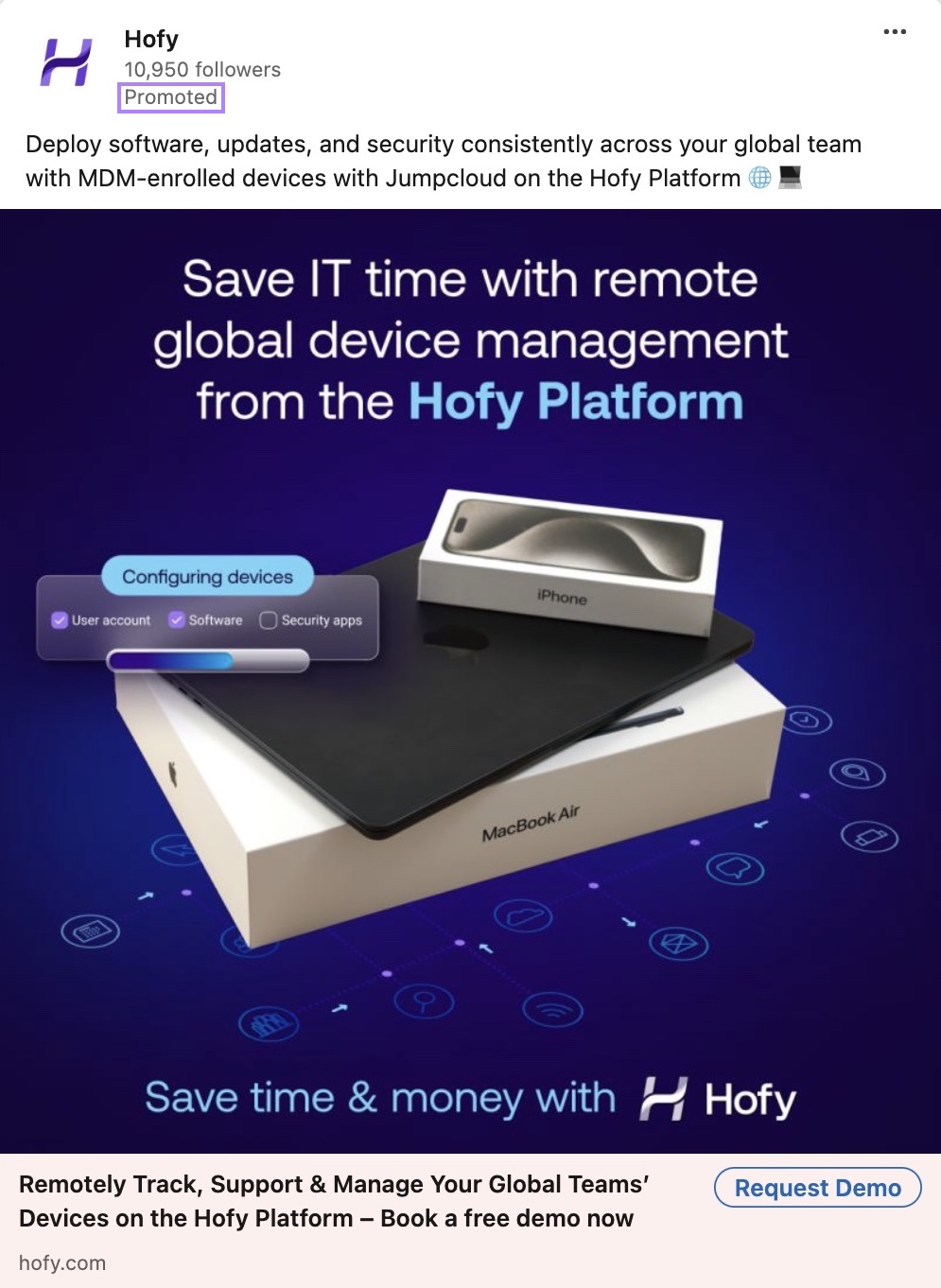
Here are some benefits of paid social over organic:
- Targeted reach: You can pinpoint what kind of people you want to engage by setting specific criteria such as age, location, interests, and behaviors
- Fast visibility: You can quickly boost visibility because paid ads can start showing up in your audience’s feeds as soon as you fund your campaigns
- Track results: You can closely monitor the effectiveness of your campaigns by tracking metrics like engagement rate, click-through rate, and conversions
As with paid search ads, there are various places your paid social media content can appear. Including in users’ feeds, stories, and videos, like Instagram Reels.
5. Email
Email is another powerful customer acquisition channel. Because billions of people use email to communicate with others.
You can leverage this channel to directly communicate with your potential and existing customers.
Here’s an example from Airtable, where they communicate the launch of their new feature, Airtable AI, through email:
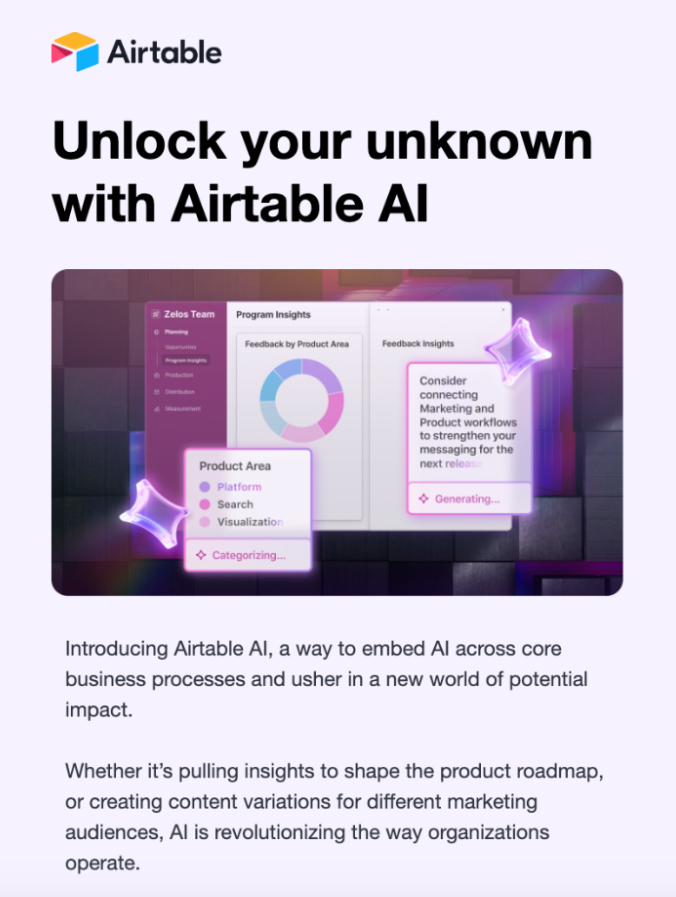
Unlike many other customer acquisition channels, where algorithms can have a major impact on your visibility, you have (almost) full control over email.
You can leverage this channel for different purposes. Like educating potential customers about your products and promoting new offerings.
Further reading: What Is Email Marketing? The Definitive Guide for Beginners
6. Podcast Streaming Platforms
More than 460 million people listen to podcasts. Making podcast streaming platforms (like Spotify and Apple Podcasts) great channels for customer acquisition.
Imagine you own a small coffee shop.
By hosting a podcast that focuses on discussions about coffee beans and brewing techniques, you can attract an audience interested in specialty coffee and café culture.
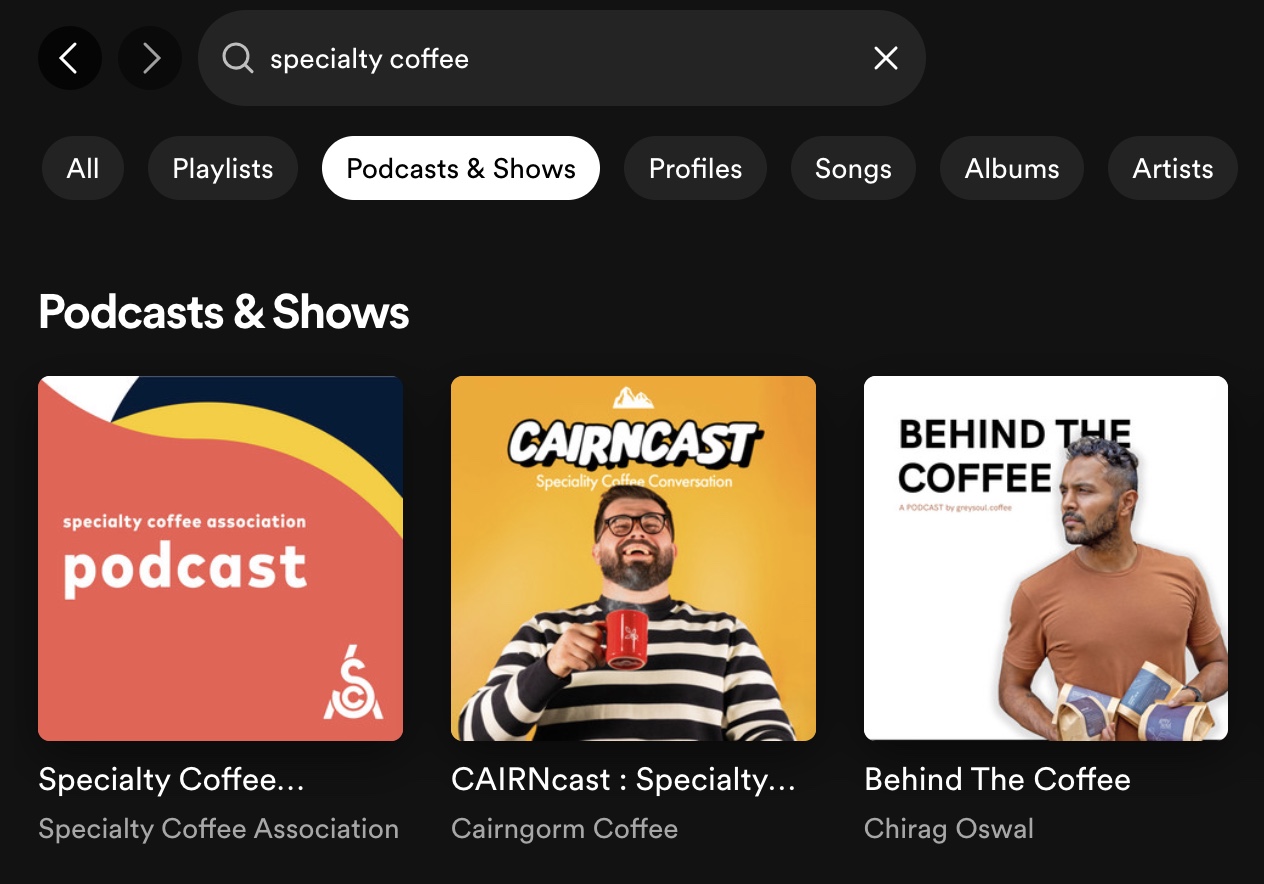
By sharing your expertise and passion for coffee, you can build trust and establish your brand as a thought leader in the coffee industry.
You can also appear as a guest on other popular coffee-related podcasts or invite experts to speak on your own podcast.
When you invite industry experts to your show, it enriches your podcast with diverse knowledge and perspectives. Making it appealing to regular listeners.
Similarly, by appearing on other podcasts, you can tap into the host’s established following and authority to expand your reach. And further build trust and authority with potential customers.
6 Winning Customer Acquisition Strategies
Here are six customer acquisition strategies to suit the channels we discussed above:
1. Search Engine Optimization (SEO)
Search engine optimization (SEO) is the process of improving a website’s search engine visibility through non-paid tactics.
These tactics involve publishing high-quality content and optimizing it for both users and search engines. Helping you improve visibility and attract more customers.
The higher your website ranks on search engines, the more likely it is to be seen by potential customers.
A Backlinko study of around 4 million Google Search results revealed that:
- The first organic search result attracts 27.6% of all clicks
- The second position receives 15.8%.
- The third organic search result garners 11% of the total clicks
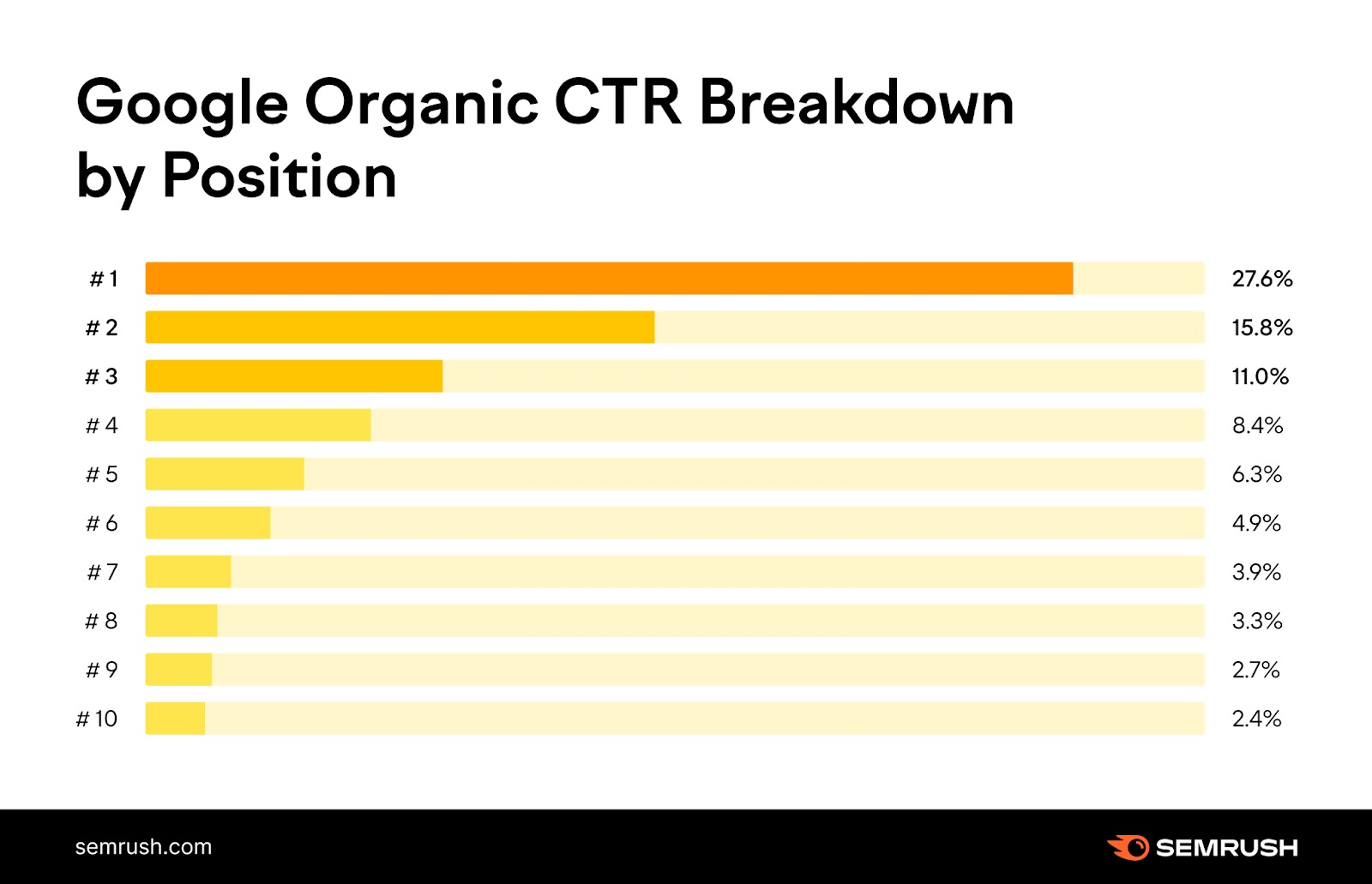
SEO involves a lot of different strategies and techniques, including:
- Finding the right keywords for your business
- Making your website mobile-friendly
- Adding on-page SEO elements (like title tags and headers) to your webpages
- Linking internally to other important pages and posts
And much more.
Semrush offers a wide range of tools to guide your SEO efforts.
Like the Keyword Magic Tool. It helps you identify relevant keywords for your business. Which you can target on your website to improve your rankings.
To get started, enter a seed keyword (a broad term related to your business). Select a target location and click “Search.”

Next, you’ll see a list of related keywords. Along with key metrics like search intent, search volume, and keyword difficulty.
To find keywords that are most likely to lead to customer acquisition for your business, narrow your search down with filters.
For example, you can filter for terms with lower keyword difficulties. To do this, click the “KD %” filter and set a custom range of 0-49. Then click “Apply.”
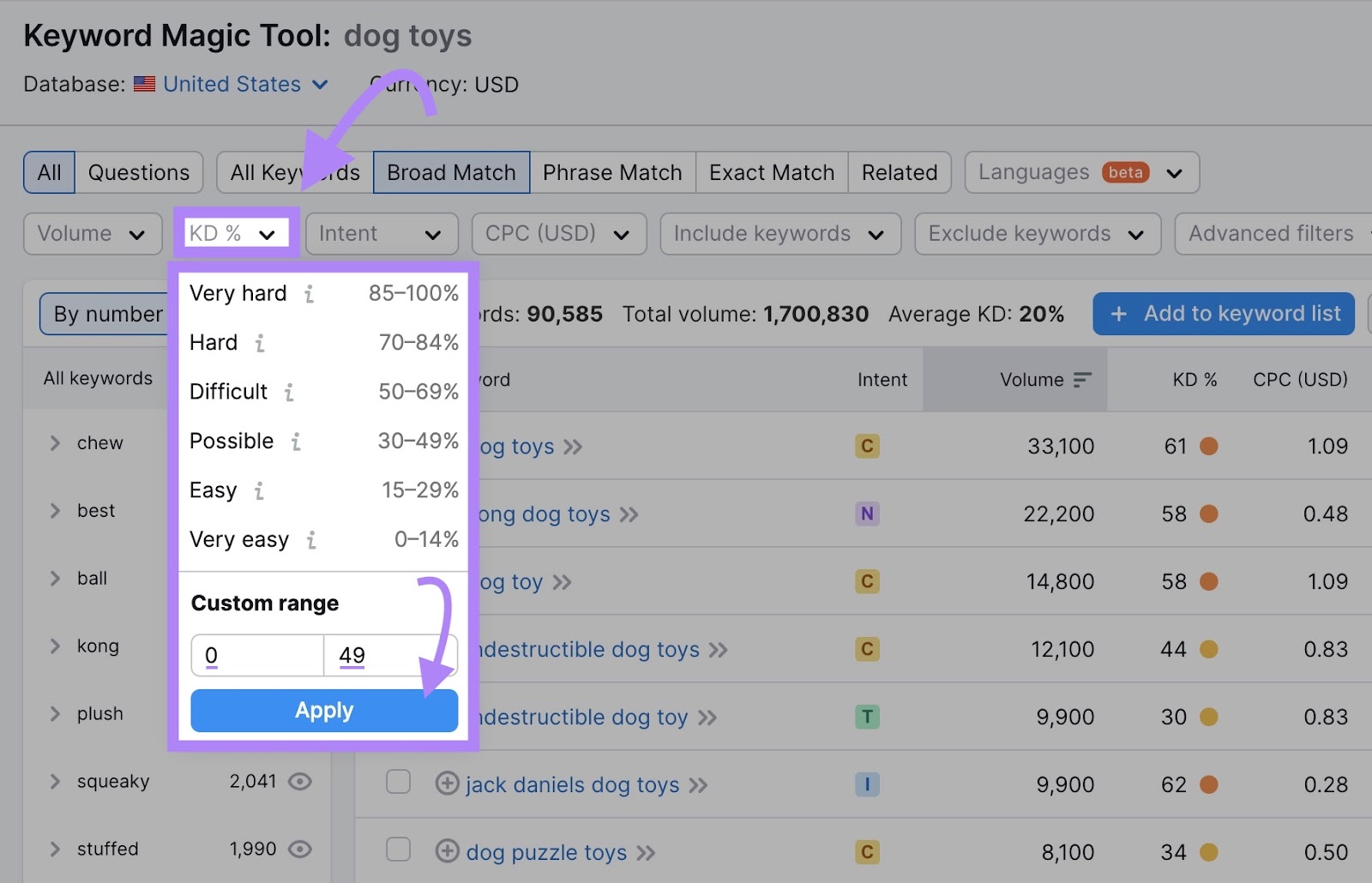
You can also filter by intent. This lets you only show keywords that, for example, suggest the searcher is closer to the conversion stage of the customer acquisition funnel.
To do this, click the “Intent” filter and select “Commercial” and “Transactional.” Then click “Apply.”
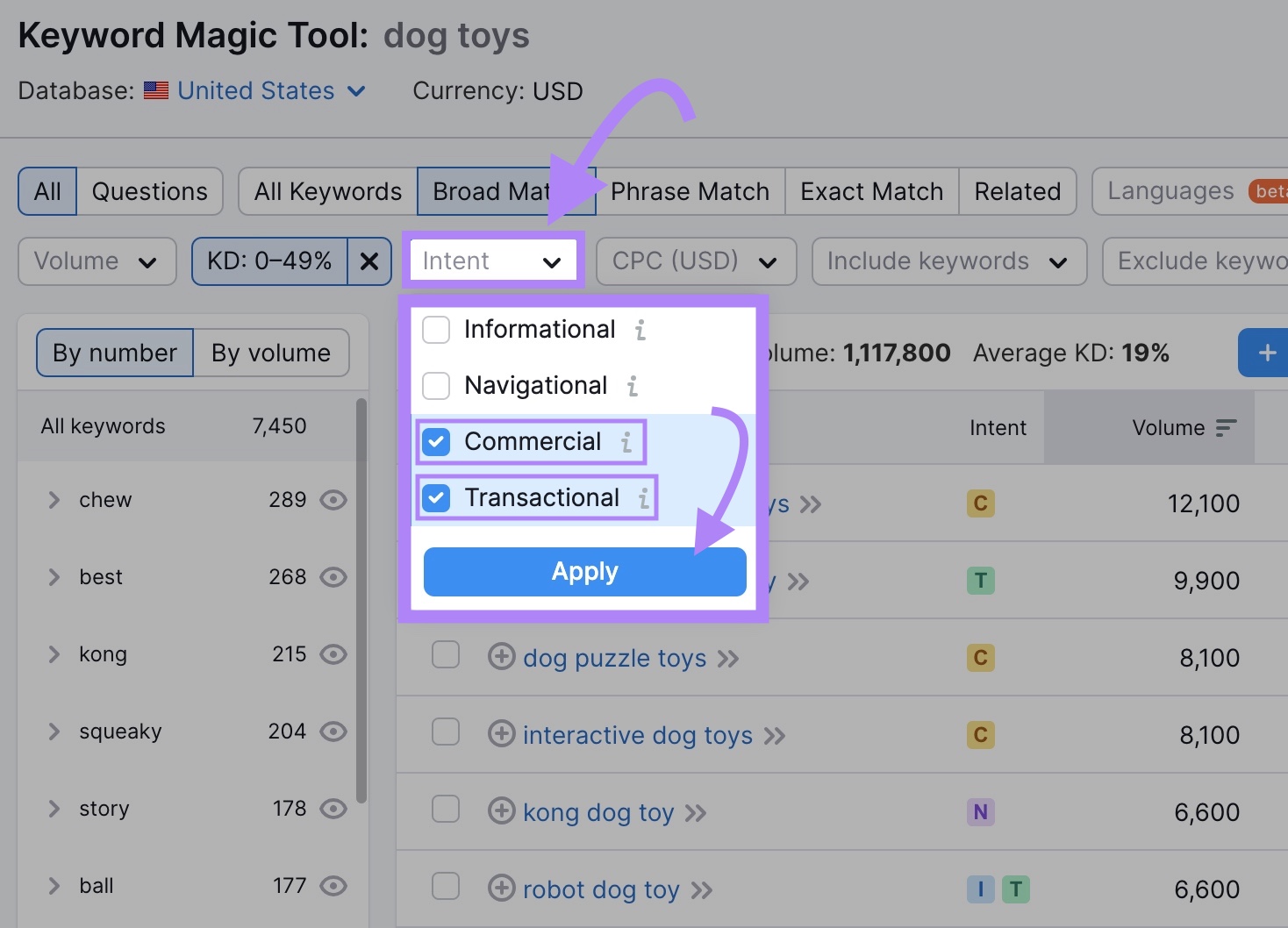
In the list below, you may want to target terms like “dog toys for aggressive chewers.” It’s a specific keyword with high search volume and a relatively low keyword difficulty. Plus, it has transactional intent (denoted by the “T”), indicating the searcher is ready to buy.

Once you have a list of keywords to target, you can then create and optimize high-quality content for those terms. And hopefully drive potential customers to your website through organic search.
2. Paid Advertising
You can run paid advertising campaigns on search engines, like Google and Bing. And on social media platforms, like Facebook and LinkedIn.
Obviously paid ad campaigns cost money. So this is only a viable customer acquisition strategy for those with the budget.
However, it can yield results much faster than a strategy like SEO. Making it an ideal choice for businesses that need to convert users quickly. Or for launching products or special promotions that are time-sensitive.
Use Semrush’s advertising tools to guide your paid ads efforts.
For example, the Advertising Research tool helps you review your competitors’ ads with ease. To find out what’s working for them and gain insights to adapt your own strategies.
Enter your competitor’s website URL and select your target location. Then click “Search.”

Then click the “Ads Copies” tab.
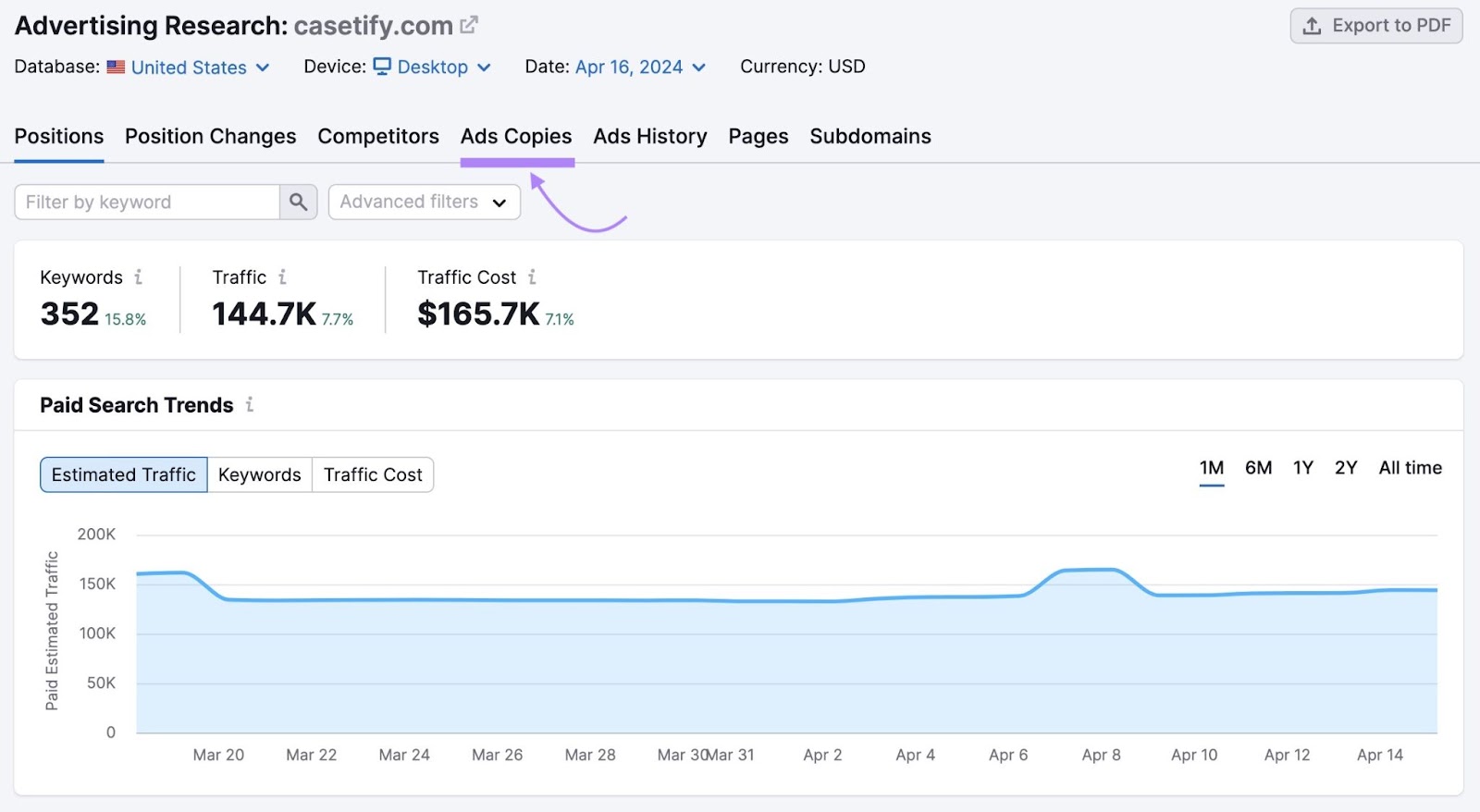
Here, you can see a list of ads your competitor has used, and the copy each ad contained. Clicking the “Keywords” drop-down under one of the ads will show you all the keywords the ad could show for. Along with search volume and the cost per click.

You can use these as inspiration to run a winning paid search campaign for your own business.
3. Social Media Marketing
Social media marketing refers to the use of social media platforms to naturally attract and engage your audience. It involves:
- Building a social media strategy
- Publishing high-quality content consistently on social media channels where your target audience is most active
- Interacting with your target audience, typically through comments
- Analyzing and reporting on platform-specific metrics
Social media marketing can help you reach more customers. But it requires significant time investment.
Use the Semrush Social toolkit to streamline the social media management process. For example, use the Social Poster to draft, schedule, and post content on multiple social media channels at once.
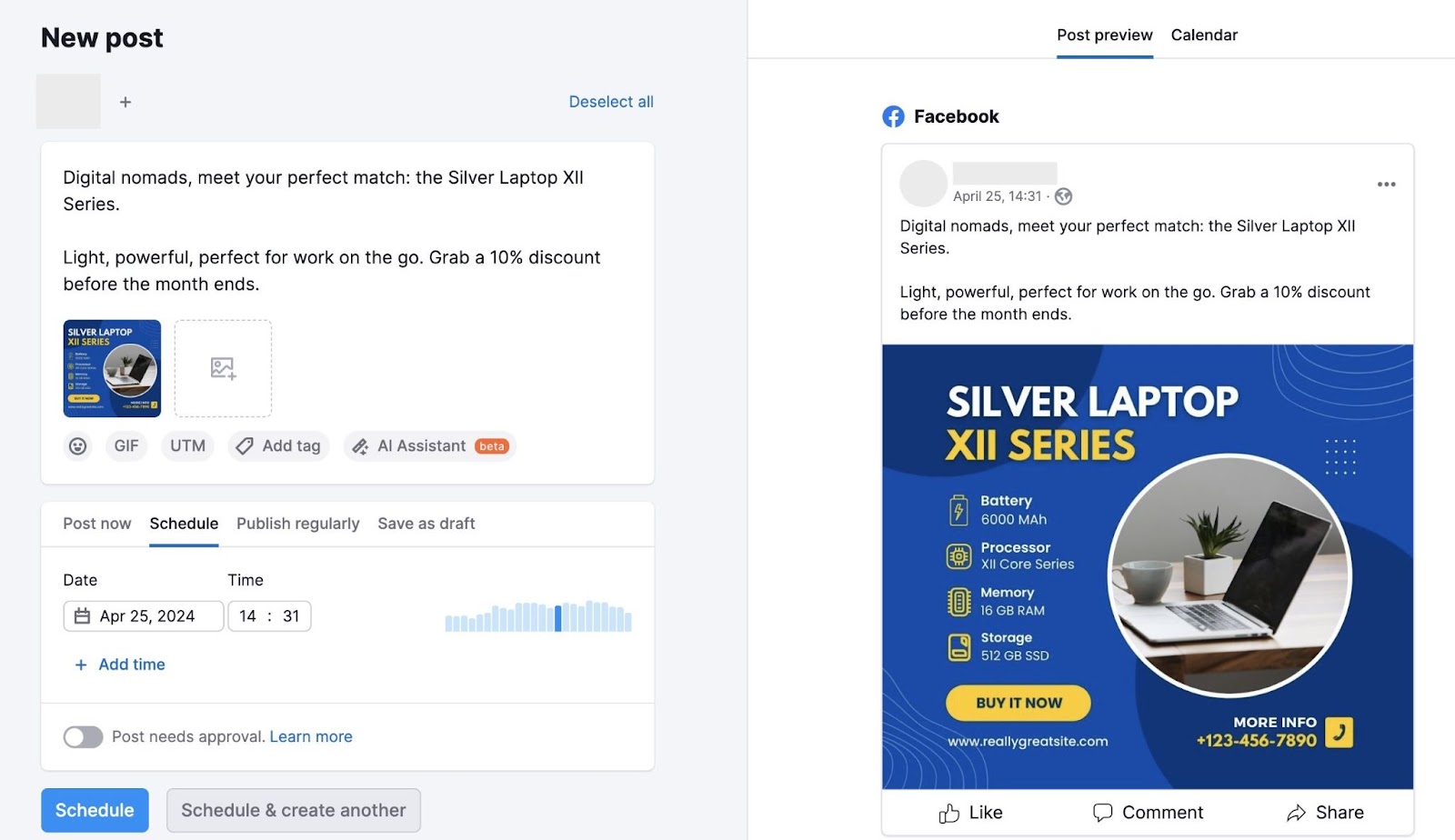
Use Social Tracker to analyze your competitors’ social media presence. And compare their growth and engagement to yours.

And use Social Analytics to measure your social media marketing efforts. To monitor your followers and engagement levels for Facebook, Instagram, and LinkedIn all in one place.
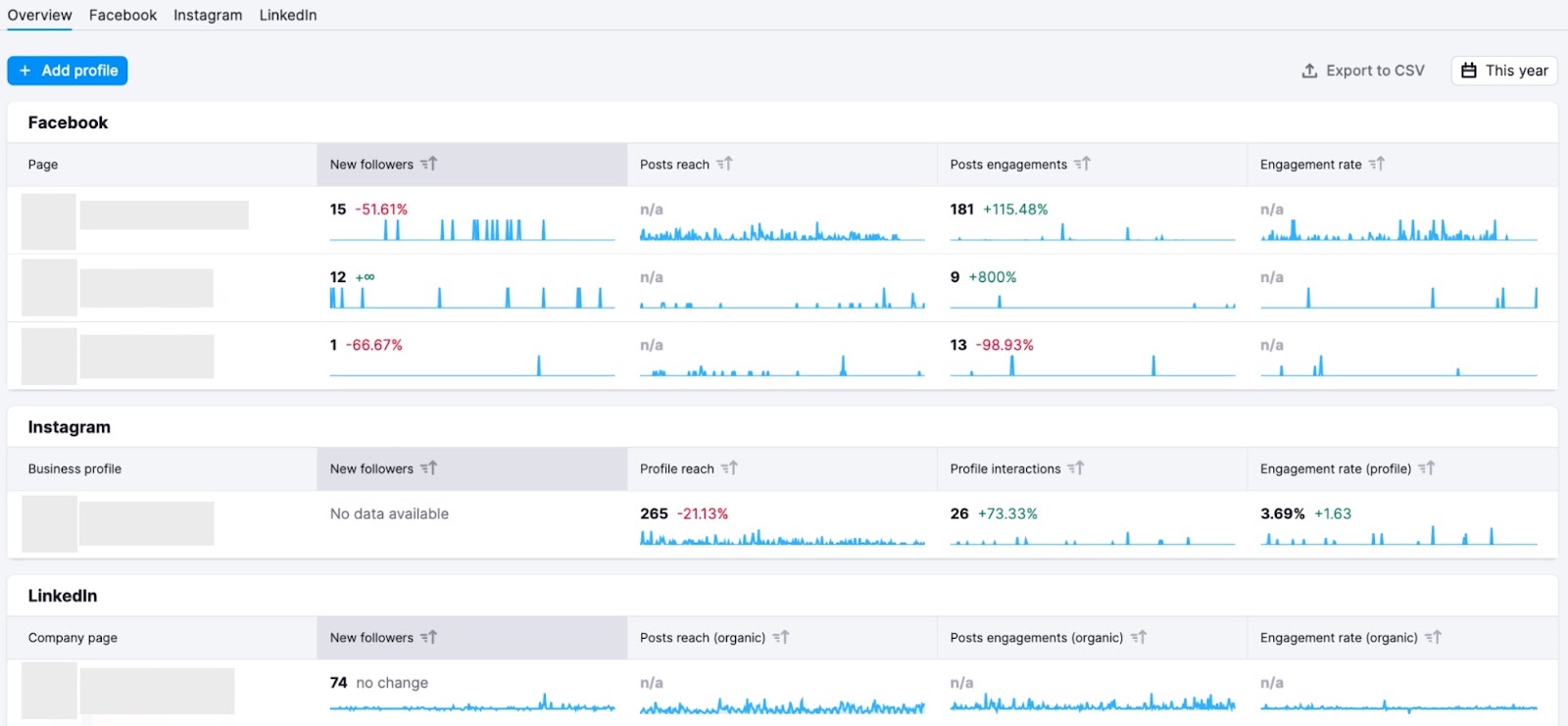
Finally, use Social Inbox to receive and respond to social media messages across different platforms, all in one place.
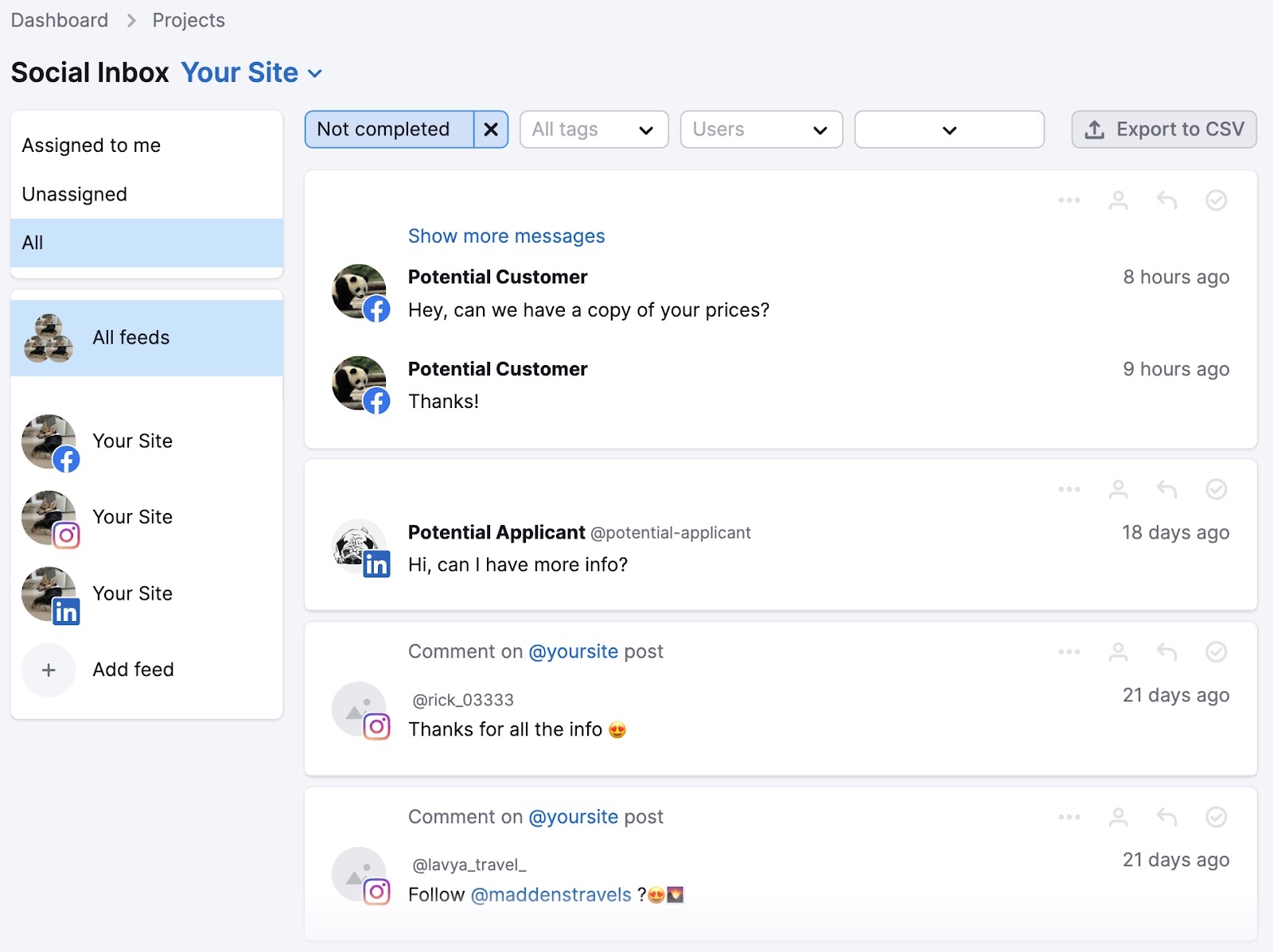
These tools make managing your social media marketing strategy straightforward and less time consuming. So you can focus more on customer acquisition, rather than juggling lots of different platforms at one time.
4. Content Marketing
Content marketing involves producing and sharing valuable online content (like blog posts, how-to guides, videos, podcast episodes, and emails) to attract and engage your target audience.
You can create content for different customer acquisition channels like organic search, organic social, email, and podcast streaming platforms.
Content marketing can increase brand awareness, build trust, and establish authority. Helping you generate more leads and conversions.
Content marketing is more than just producing and sharing content online. You need to produce content that’s valuable, engaging, and interesting. It should:
- Address your audience’s needs and problems
- Provide them with a solution
- Catch their attention at first glance and keep them engaged
- Encourage your readers/viewers to take action
Use the Topic Research tool to generate ideas for engaging content. Enter a broad topic related to your business. Let’s imagine you offer graphic design tuition services and you also offer courses as a digital product.
Select your target location and click “Get content ideas.”
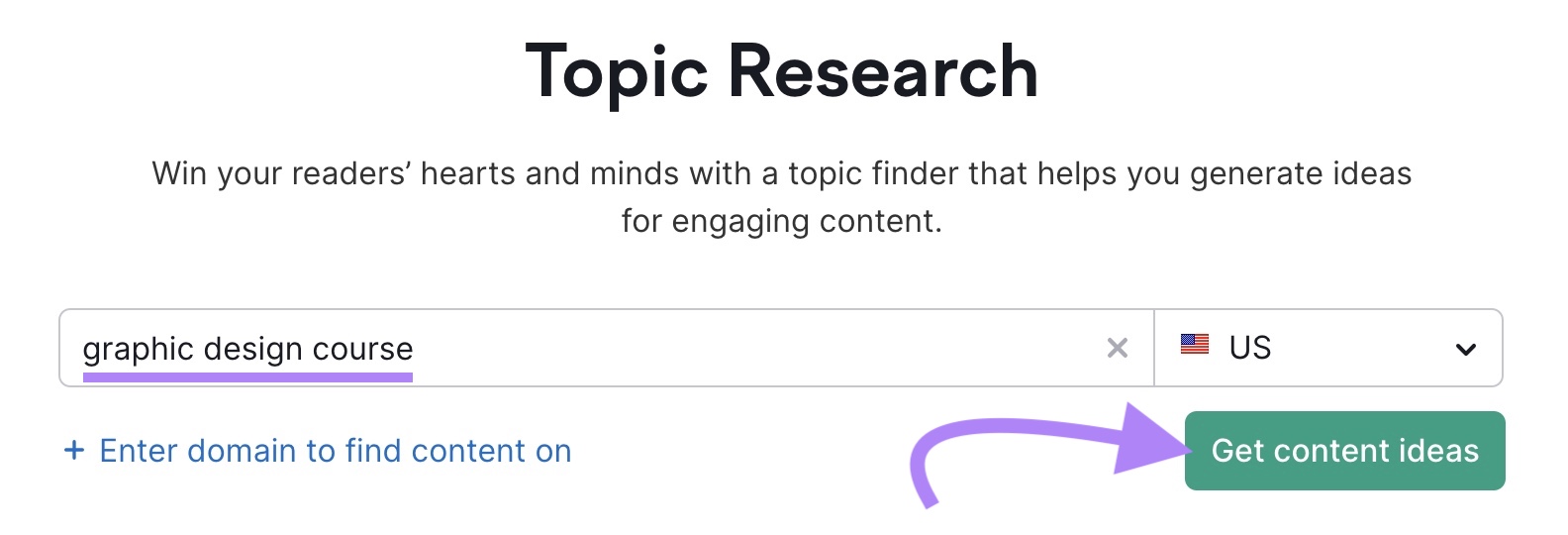
The tool will display cards of related topics for you to create content around. Clicking “Show more” under one of the cards displays top headlines and questions for that topic.
Along with search volume, difficulty, and topic efficiency (where high topic efficiency means high volume but low difficulty).

Use these topic ideas to create content. Or to optimize your existing content with relevant subheadings and questions your target audience is asking.
For example, you could create blog posts that answer questions surrounding where people can learn graphic design and how they can learn logo design. Then you can point to your course within those blog posts as a way to acquire customers.
5. Video Marketing
Video marketing uses videos to market your product, service, or brand.
It involves planning, producing, editing, and sharing videos on different channels. Like YouTube, social media, and your website.
Here’s an example from GoPro’s YouTube channel:
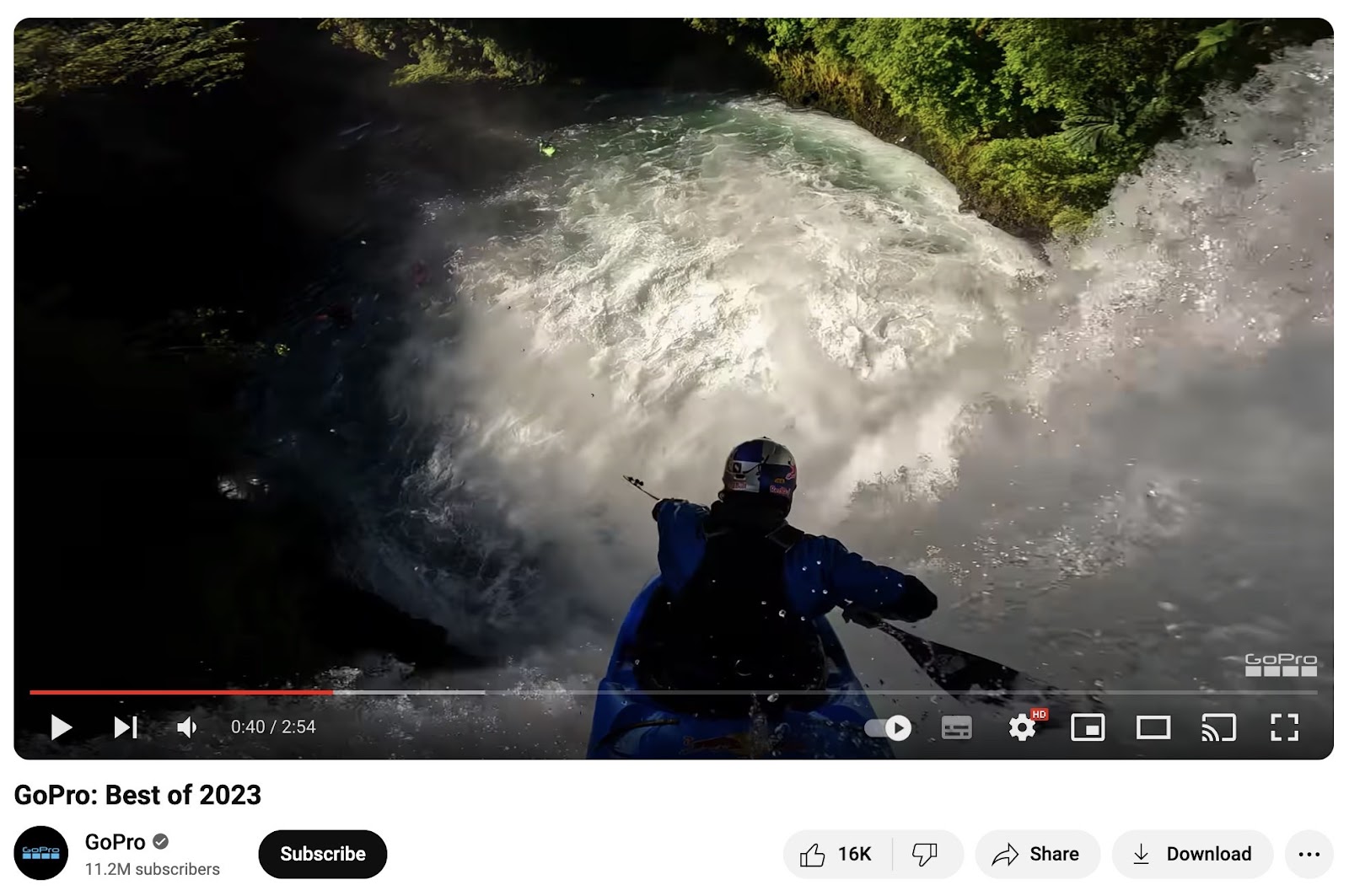
The video showcases user-generated content in a way that also shows off GoPro’s product. Making it a great blend of entertaining content and product promotion.
You can create different kinds of videos to suit different customer acquisition strategies:
- Educational: To educate your audience about a specific topic revolving around their pain points
- User-generated: To showcase real-life customer experiences related to your product, service, or brand (like the GoPro example above)
- Product walkthroughs: To demonstrate how your product works
- How-to: To deliver practical advice or instructions on achieving specific tasks using your product
- Case study: To showcase results achieved by your customers after using your product or service
You can use videos to establish a strong organic presence (as videos often show up in Google search results).
And you can use them in your paid ad campaigns. To increase the chances of catching your audience’s attention. And making them click-through to your landing pages.
Further reading: Video Marketing: The Ultimate Guide for 2024
6. Email Marketing
Email marketing involves sending targeted emails to your email list. This is a list of email addresses of people who have signed up to receive emails from your business.
You can run email marketing campaigns to:
- Keep your subscribers engaged, by sharing valuable content like blog posts
- Inform potential customers about upcoming product launches
- Promote special offers or discounts to encourage sales
- Announce events or webinars
Segment your email list to deliver more personalized and relevant content to different groups of subscribers. Based on their interests, behaviors, and stages in the customer journey.
Different types of emails you can create include:
Educational Emails
Educational emails help you address and provide a solution to the problems your target audience faces. Further helping you build trust and establish your brand as an authority in the field.
The Semrush Newsroom email newsletter is an example of this. It provides readers with the latest SEO news, along with helpful tips and resources.

Promotional Emails
Promotional emails can help you encourage purchases. By showcasing special offers, discounts, or new products to encourage purchases.
This email, by Old Navy, uses a sense of urgency to drive purchases. The countdown clock indicates that a 40% off everything sale is ending soon. Also, the use of "online exclusive" suggests that this offer isn’t available in physical stores.
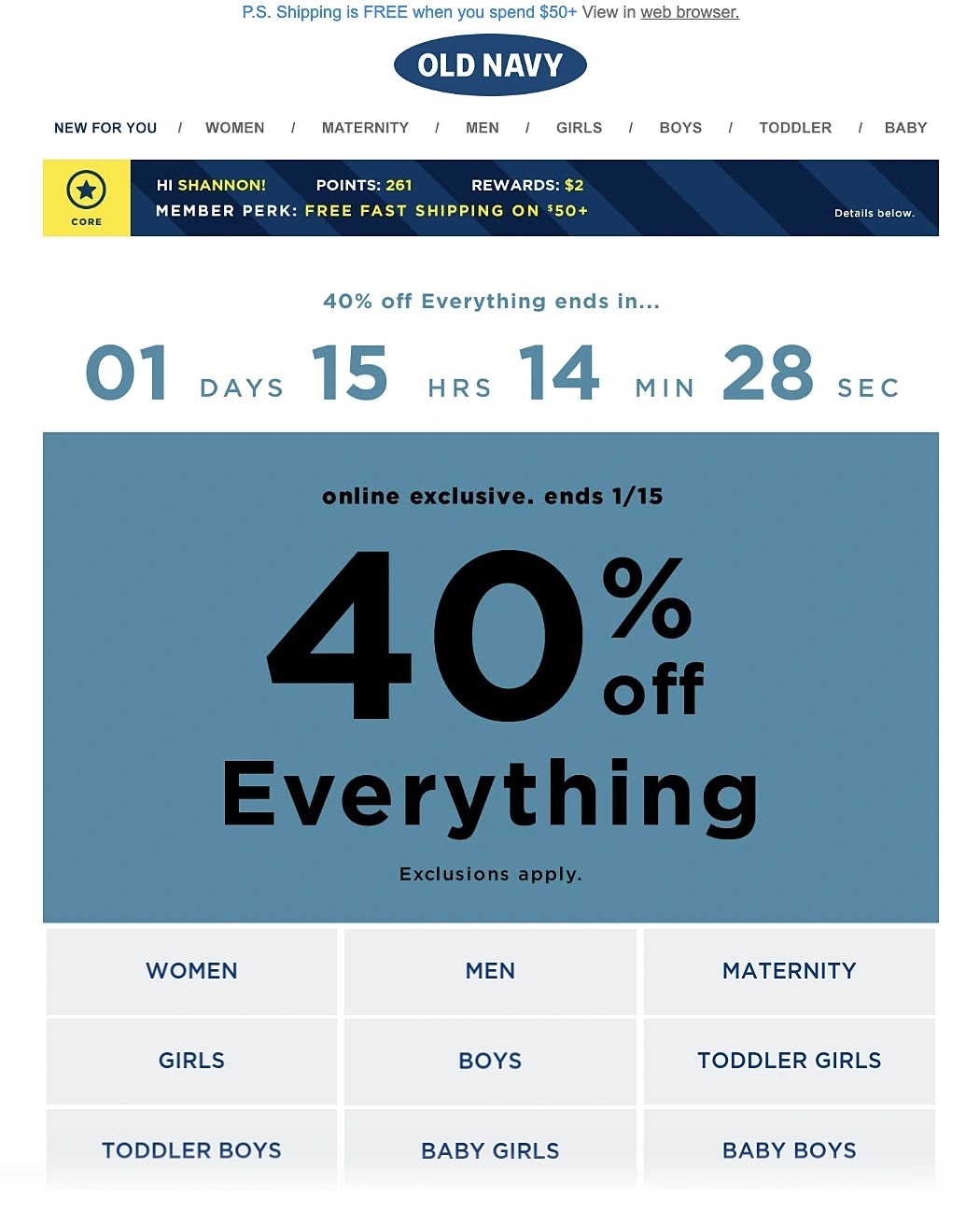
Re-Engagement Emails
Re-engagement emails can help you reconnect with subscribers who haven't interacted with your brand in a while.
This email by Grammarly is a clever example of a re-engagement email. The playful concept of a “Wrinkle in Time Badge” adds a touch of humor and acknowledges the user's absence without being pushy.
Also, it encourages the recipient to come back and continue using the service by reminding them of the value Grammarly adds to their writing.
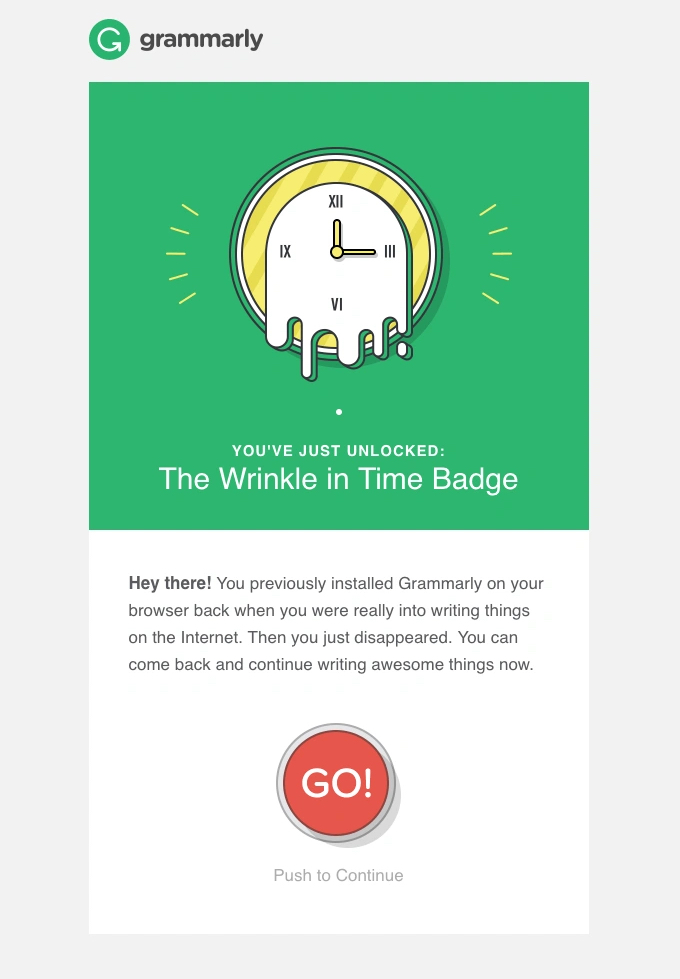
How to Build a Customer Acquisition Plan
Follow these steps to create a winning customer acquisition plan for your business:
1. Define Your Target Audience
Defining your target audience gives you clarity on:
- The challenges they face
- How they make purchasing decisions
- What kind of content they like to consume
- Which platforms they use
- Their interests
To find out detailed information about your target audience and where they hang out, use Semrush’s One2Target tool.
To start, enter up to five competitor URLs (your competitor’s target audience is likely similar to yours). Then, click “Analyze.”

The tool will then provide information about your competitors’ target audience. Like their demographics, behaviors, and socioeconomics. You can find out which platforms your target audience uses by clicking the “Behavior” tab.
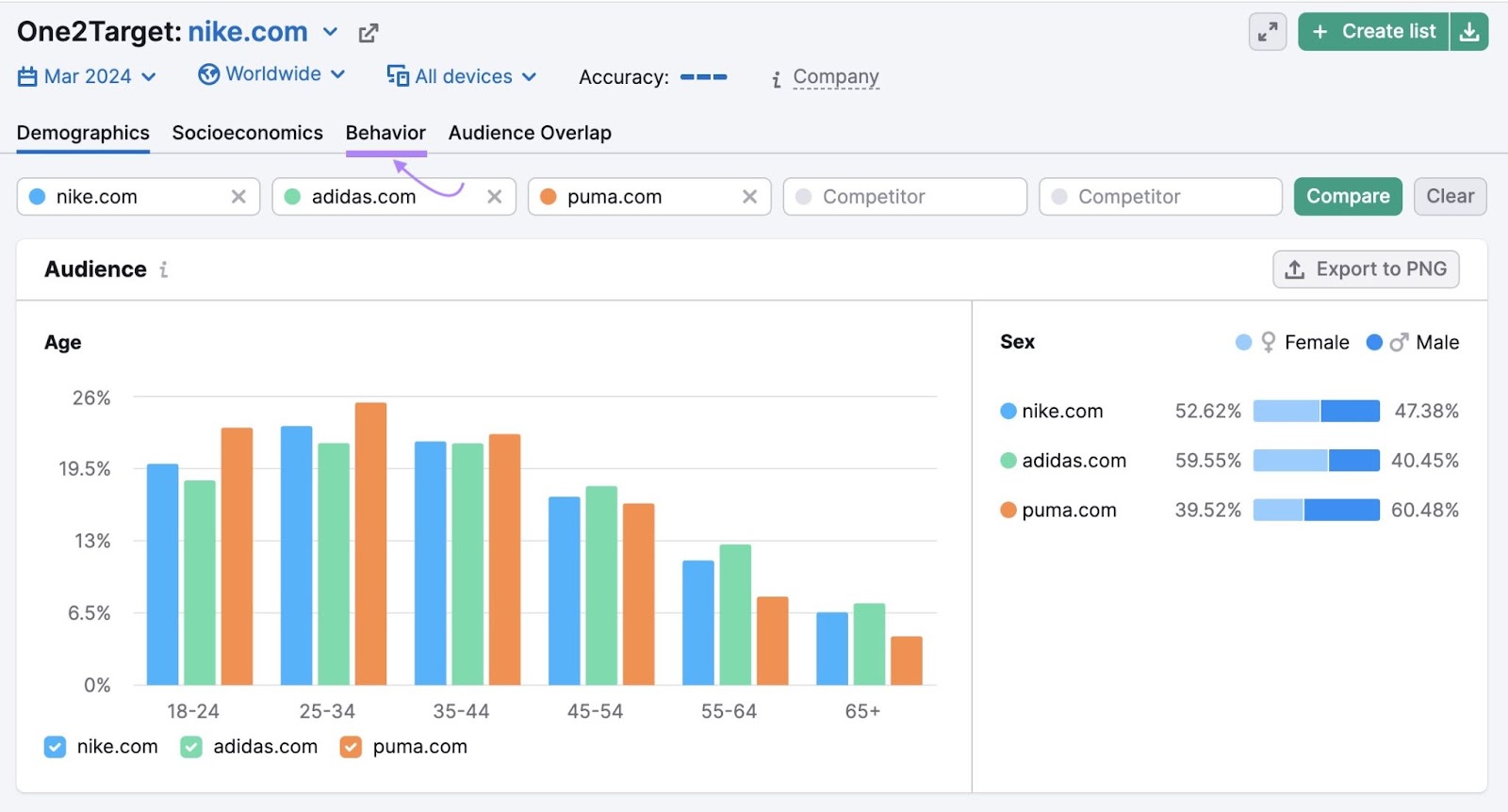
This shows you which social media platforms are most popular with each competitor’s audience. Use this information to understand which social media platforms might be the best customer acquisition channels for your own business.
2. Perform Competitive Analysis
A competitive analysis is the process of researching your competitors to better understand their product, sales, and marketing strategies.
You can use this research to identify their strengths and weaknesses. And discover opportunities.
Performing competitive analysis lets you:
- Better understand your target market, industry, and customers
- Find out who your direct competitors are
- Understand what customer acquisition channels your competitors are using
- Identify gaps in your existing customer acquisition strategy
Semrush’s Organic Research tool lets you gain insights into your competitor’s presence on search engines. Use this information to understand how you can leverage organic search as a customer acquisition channel.
To get started, enter a competitor’s domain, choose a target location, and click “Search.”

Next, you’ll see a comprehensive overview of their domain's performance in organic search results. This includes key metrics like the number of keywords they rank for, their organic traffic, and their top keywords by traffic share.
Clicking “View all # keywords” shows you all the keywords that competitor ranks for.
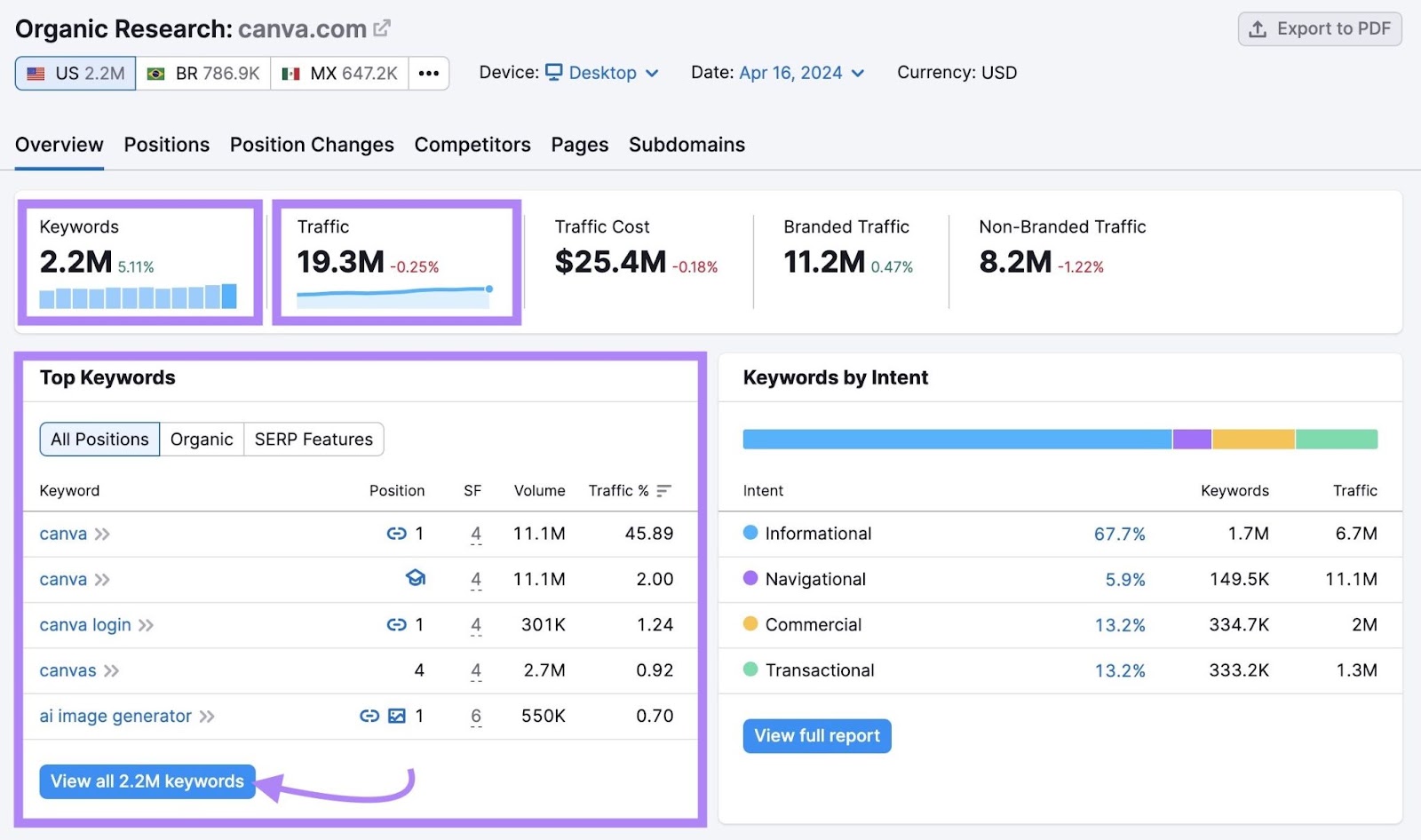
This data can give you an insight into the kinds of terms your competitors are targeting. Helping you understand what kinds of keywords you might want to target with your own content marketing efforts.
3. Set Your Goals
Setting appropriate goals will guide your customer acquisition efforts.
They should directly align with your business goals. To prove your customer acquisition efforts are directly contributing to your revenue metrics.
So, if your revenue goal is $500K in new business over the next year, you need to set customer acquisition goals that directly align with reaching this revenue target.
Use the SMART framework to do this:
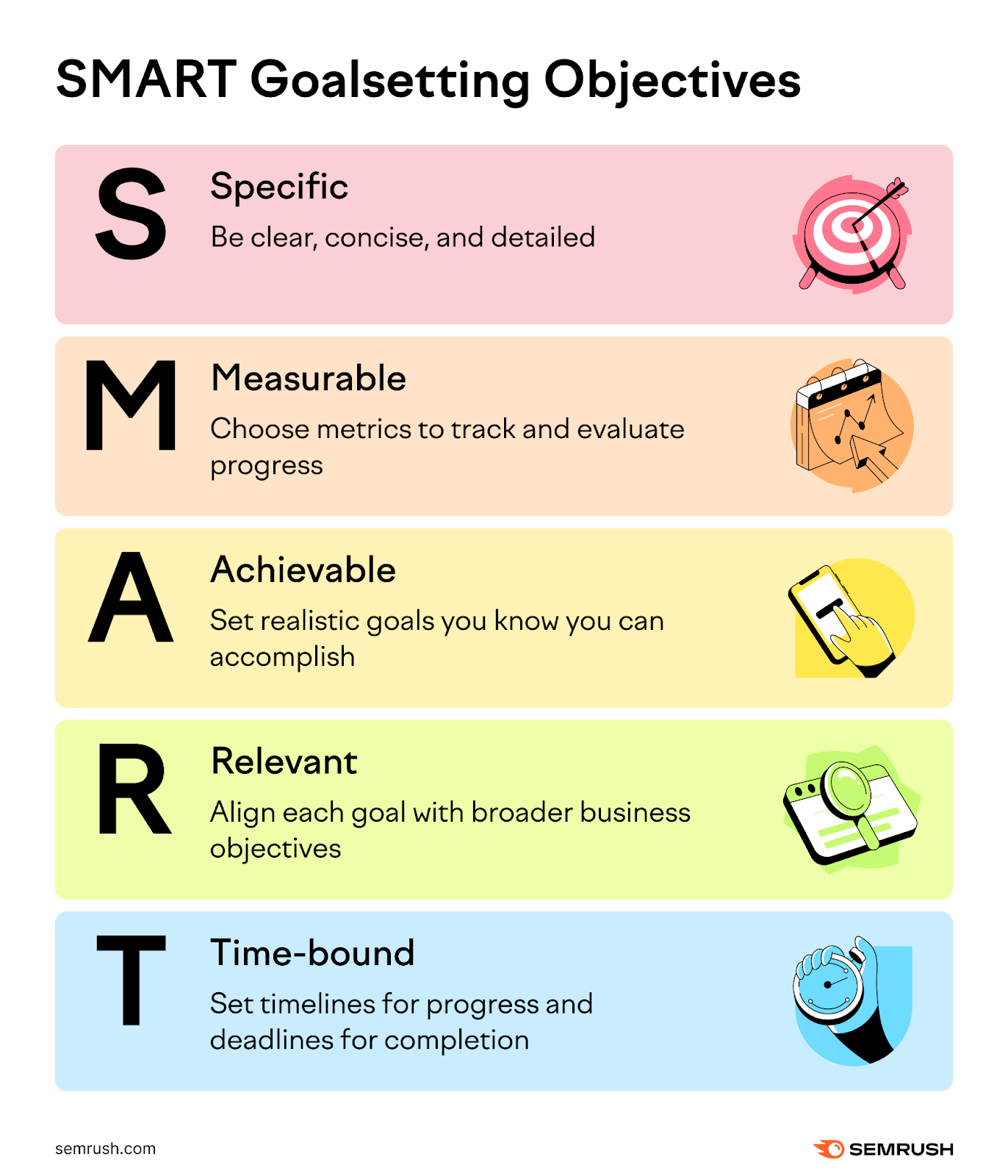
Here’s an example of a SMART customer acquisition goal:
Acquire 10,000 new website visitors by the end of Q3 through a combination of SEO and content marketing strategies.
This goal is:
- (S)pecific: Focused on increasing website visitors
- (M)easurable: Quantified as 10,000 visitors
- (A)chievable: It’s a fairly realistic number
- (R)elevant: More visitors can lead to more conversions
- (T)ime-bound: By the end of Q3 2024
Here are some more examples of SMART customer acquisition goals you can adapt to your own plans:
- Convert 2% of website visitors into email subscribers within the next 6 months by optimizing the website's call to action placements and offering valuable lead magnets
- Launch a targeted ad campaign on LinkedIn to generate 500 qualified leads in Q2, aiming for a 5% conversion rate into paying customers
4. Decide the Best Customer Acquisition Channels for Your Business
We noted above that you can find the best social media platforms to target as customer acquisition channels using the One2Target tool.
But here are a few more ways to identify the best channels for your business:
- Conduct customer surveys: Ask your existing customers (or leads) which channels they’re active on the most, or how they found your business
- Track your website analytics: This helps you understand which sources already drive traffic to your website
- Perform A/B testing: Run marketing campaigns across different channels to see which platforms deliver the best return on investment (ROI)
- Use industry benchmarks: Research industry benchmarks to understand which ones typically offer the best return for businesses like yours
You also need to consider your budget and resources. If you have a limited budget, you might have to rule out strategies like paid social and instead focus on SEO or content marketing.
And while targeting multiple channels can generate more leads and sales when done right, spreading your resources too thin can mitigate these potential gains. So you might see better results by focusing on a single channel at first.
5. Measure Your Customer Acquisition Efforts
Measuring your customer acquisition efforts can give insights into what’s working and what’s not. Helping ensure you spend your marketing budget wisely.
Here are some key metrics to track:
Customer Acquisition Cost (CAC)
CAC is the total cost of acquiring a new customer. It includes marketing and sales expenses divided by the number of new customers acquired during a specific period. You calculate it with the following formula:
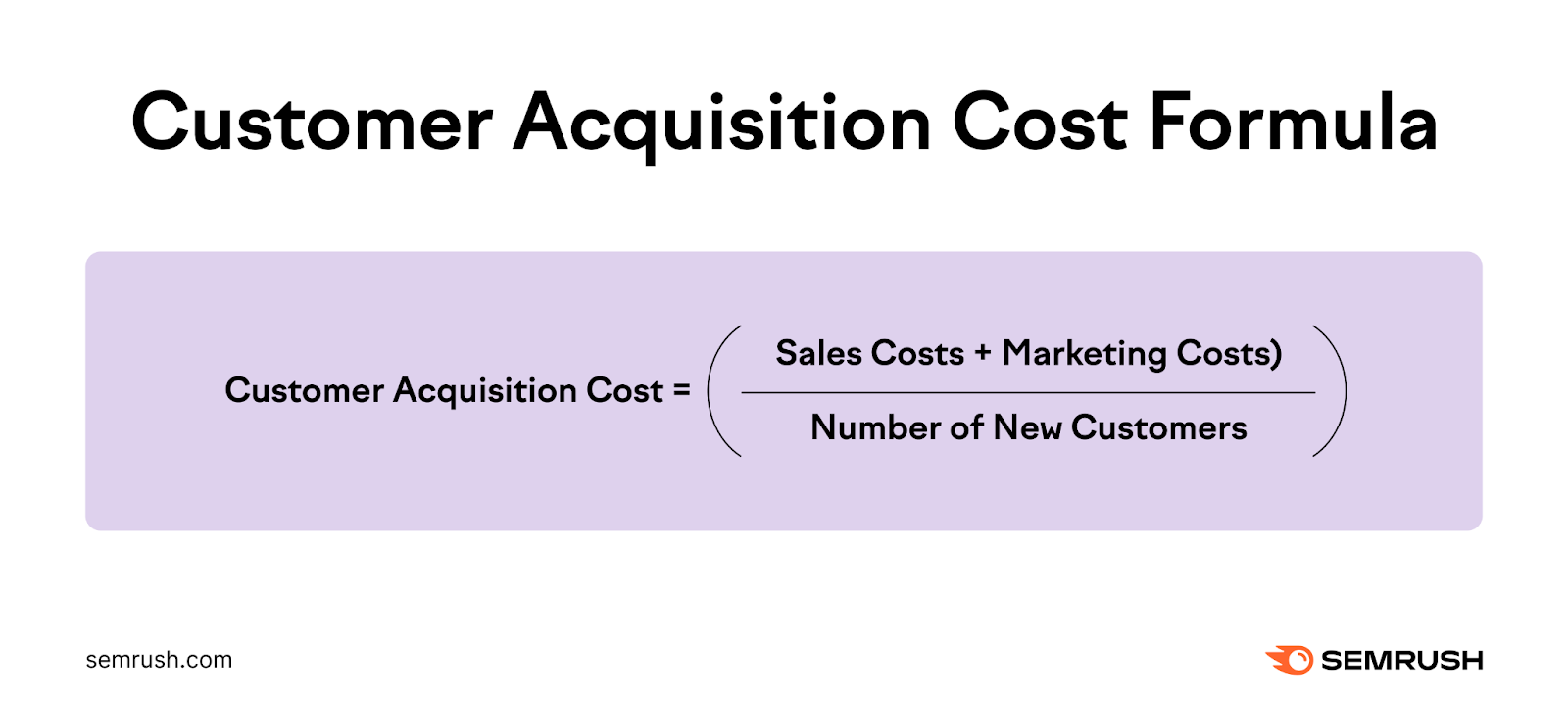
Customer Growth Rate
This is the increase in the number of new customers over a specific time frame. It reflects the business's ability to expand its customer base.
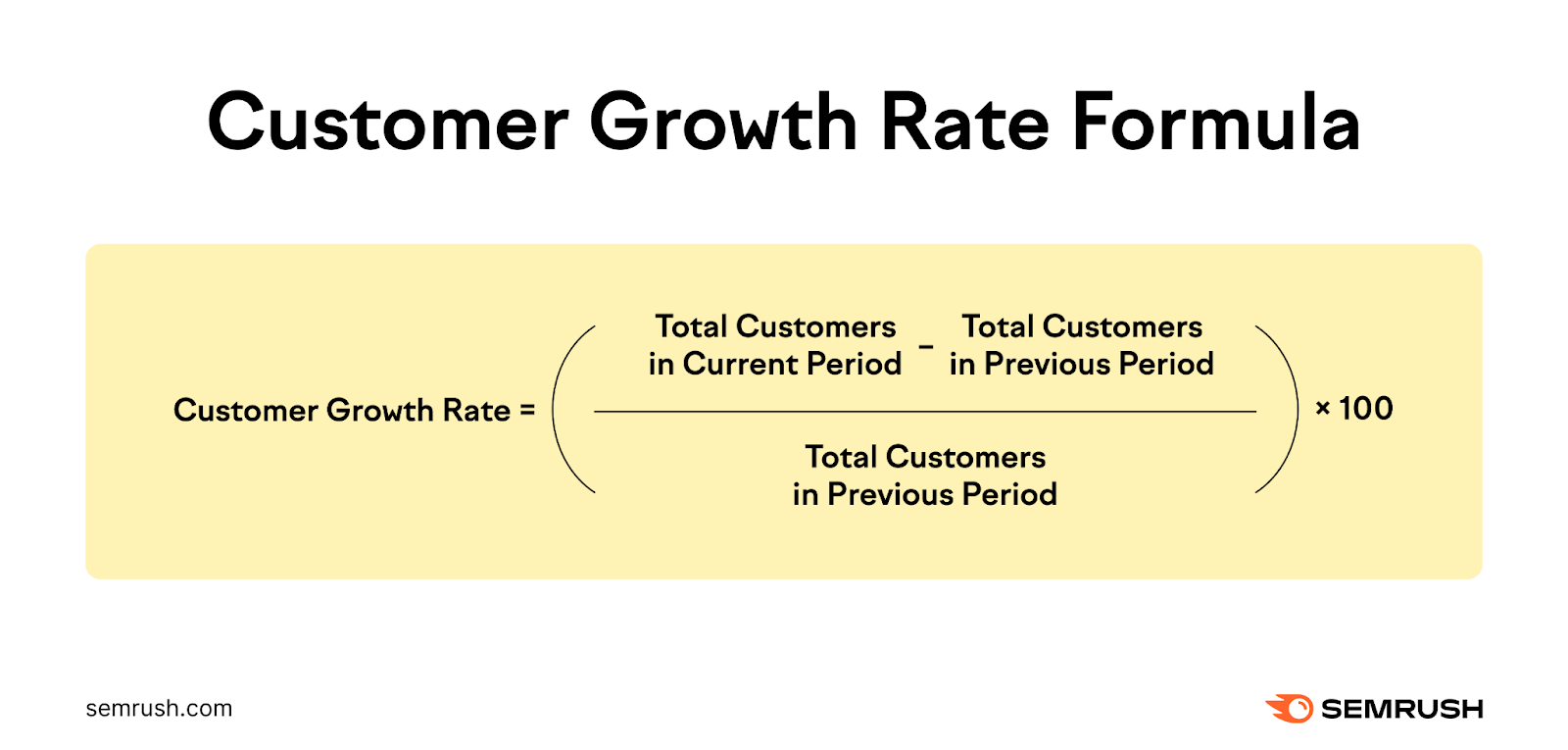
Customer Lifetime Value (CLV)
CLV is the total revenue a business can reasonably expect from a single customer throughout the business relationship.
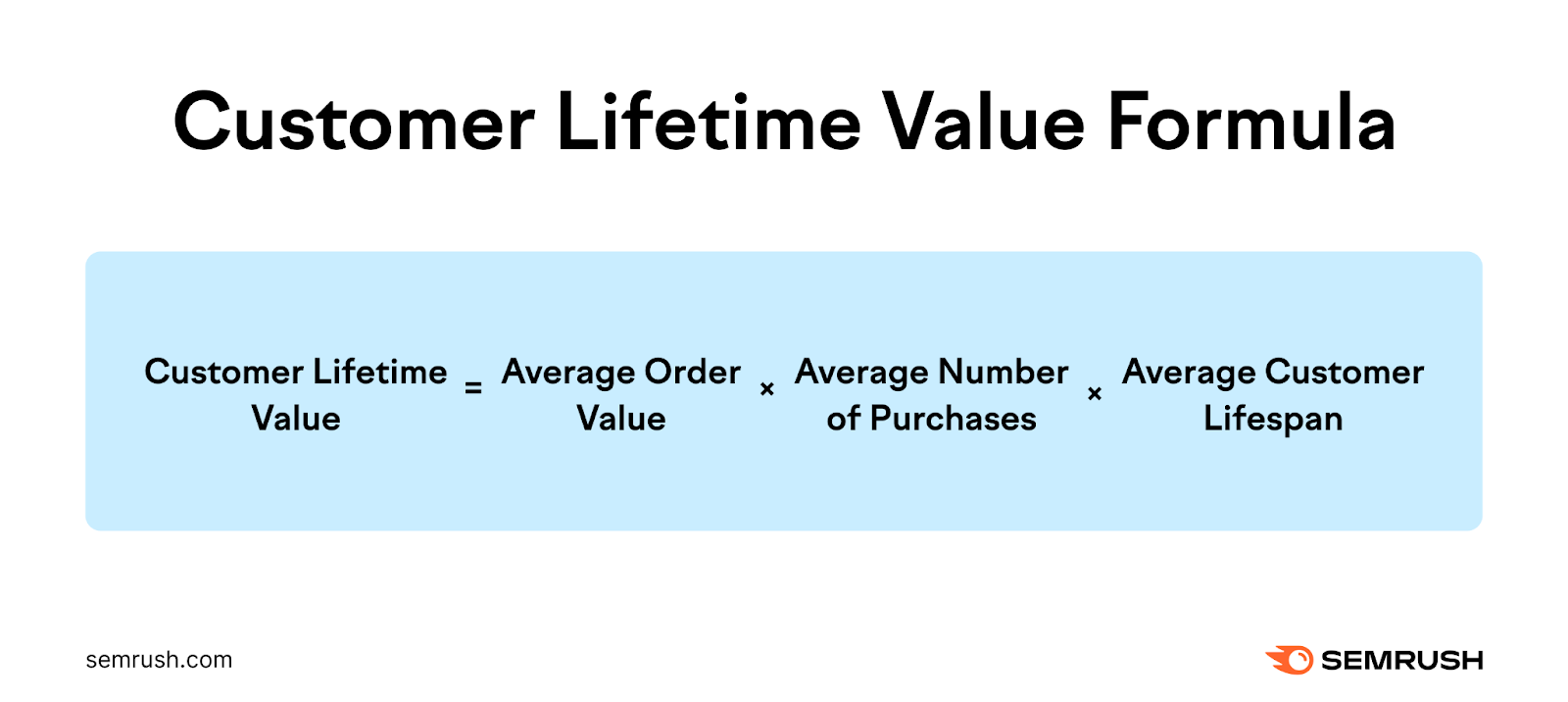
Churn Rate
Churn rate is the percentage of customers or subscribers who stop using a company's products or services within a specific time period. It's a critical metric for understanding customer retention and satisfaction.
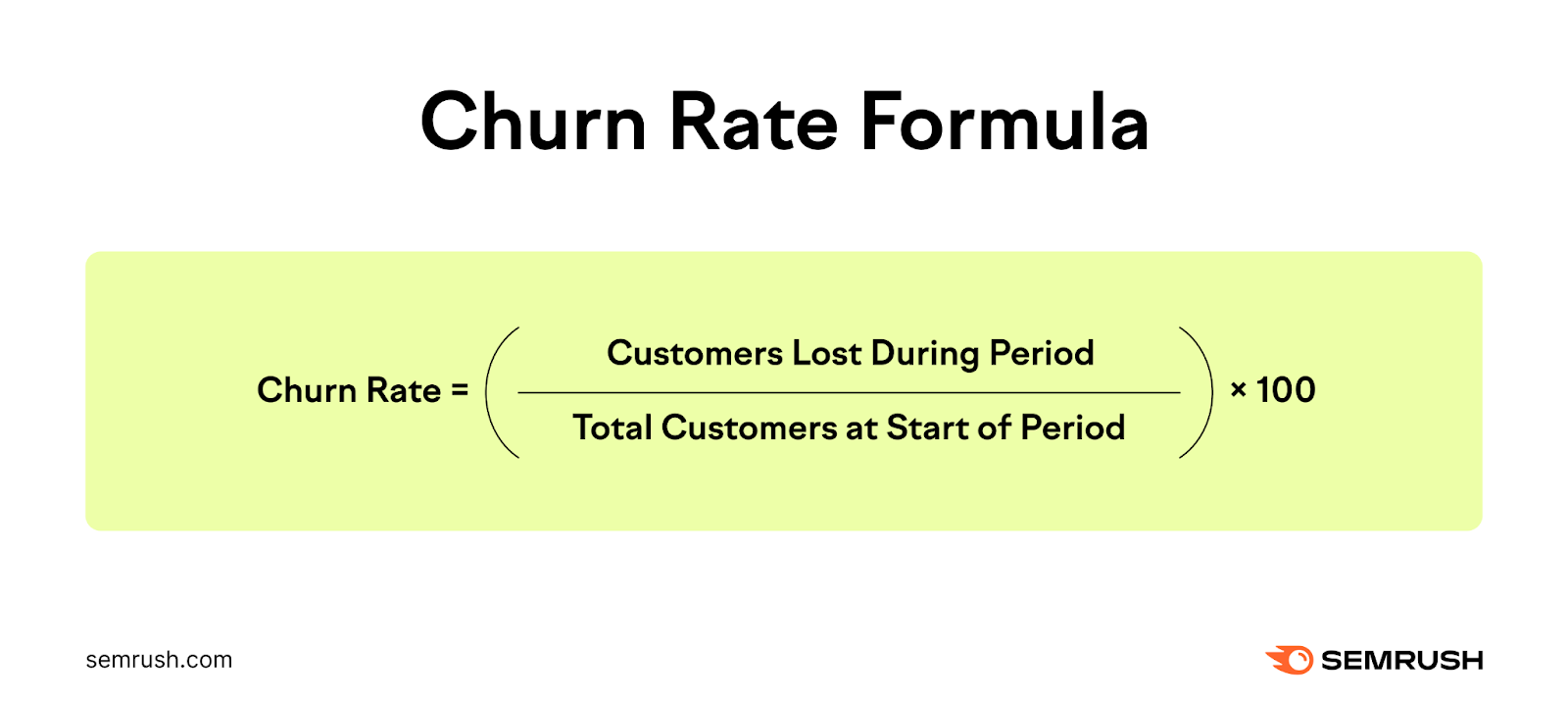
Continuously Refine Your Content Acquisition Strategy
Building a customer acquisition strategy isn’t a one-off task.
You need to measure your efforts and continuously refine it. Based on what’s working for your business. And what’s not.
Tools like Semrush can help you at every step of the customer acquisition process.
Whether it’s the Keyword Magic Tool to find terms to target with your blog content. Or One2Target for identifying the best social media platforms to run paid ads on to reach your target audience.
Get access to 55+ helpful tools and reports with a Semrush free trial.
